Managing Operations and Marketing
VerifiedAdded on 2023/06/15
|23
|5711
|299
AI Summary
This report analyzes the operational and marketing strategies of TESLA, including PESTLE, SWOT, Porter’s Five Forces, and marketing mix. It also covers market segmentation, value chain analysis, and recommendations for future growth.
Contribute Materials
Your contribution can guide someone’s learning journey. Share your
documents today.

Managing Operations and Marketing
Secure Best Marks with AI Grader
Need help grading? Try our AI Grader for instant feedback on your assignments.
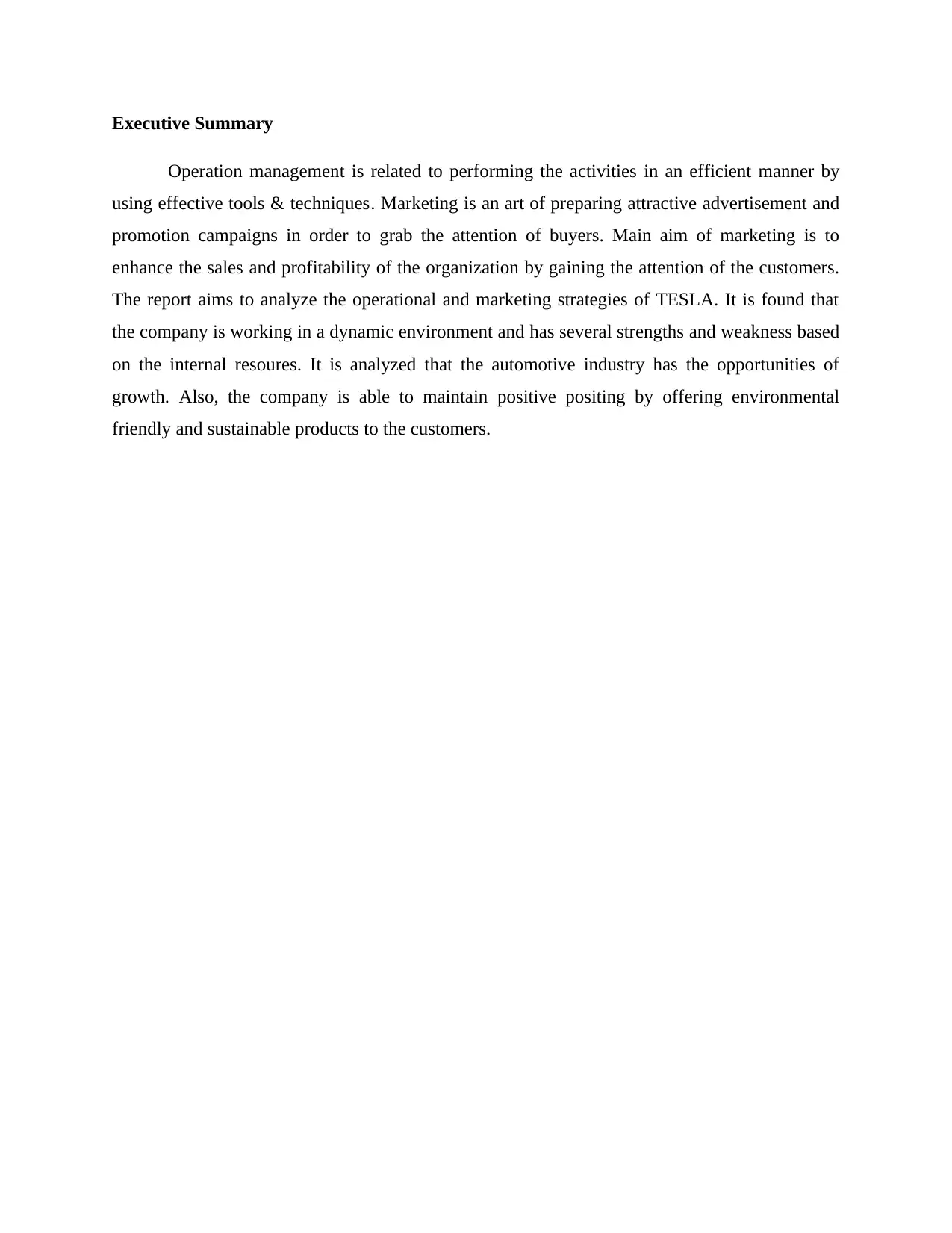
Executive Summary
Operation management is related to performing the activities in an efficient manner by
using effective tools & techniques. Marketing is an art of preparing attractive advertisement and
promotion campaigns in order to grab the attention of buyers. Main aim of marketing is to
enhance the sales and profitability of the organization by gaining the attention of the customers.
The report aims to analyze the operational and marketing strategies of TESLA. It is found that
the company is working in a dynamic environment and has several strengths and weakness based
on the internal resoures. It is analyzed that the automotive industry has the opportunities of
growth. Also, the company is able to maintain positive positing by offering environmental
friendly and sustainable products to the customers.
Operation management is related to performing the activities in an efficient manner by
using effective tools & techniques. Marketing is an art of preparing attractive advertisement and
promotion campaigns in order to grab the attention of buyers. Main aim of marketing is to
enhance the sales and profitability of the organization by gaining the attention of the customers.
The report aims to analyze the operational and marketing strategies of TESLA. It is found that
the company is working in a dynamic environment and has several strengths and weakness based
on the internal resoures. It is analyzed that the automotive industry has the opportunities of
growth. Also, the company is able to maintain positive positing by offering environmental
friendly and sustainable products to the customers.
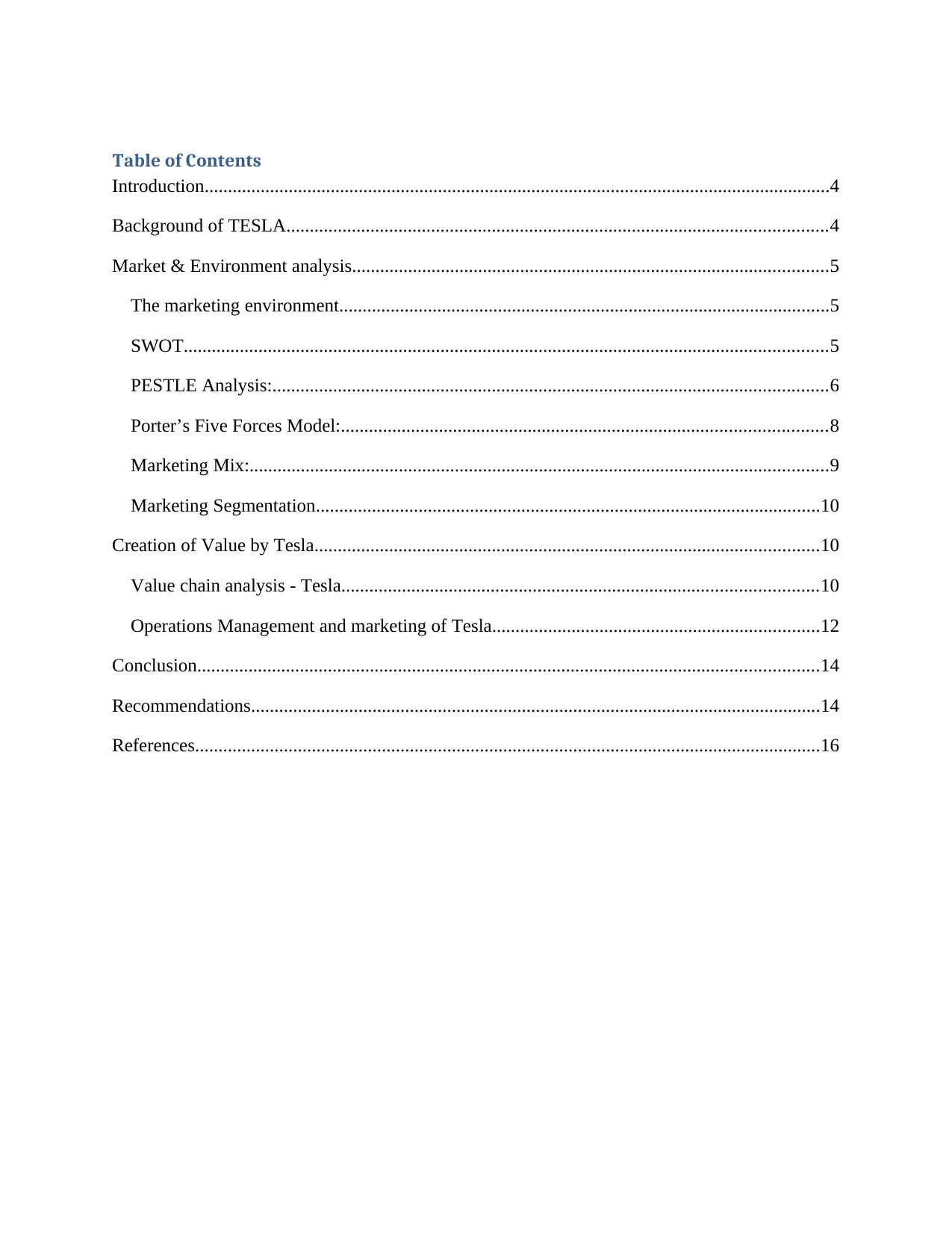
Table of Contents
Introduction......................................................................................................................................4
Background of TESLA....................................................................................................................4
Market & Environment analysis......................................................................................................5
The marketing environment.........................................................................................................5
SWOT..........................................................................................................................................5
PESTLE Analysis:.......................................................................................................................6
Porter’s Five Forces Model:........................................................................................................8
Marketing Mix:............................................................................................................................9
Marketing Segmentation............................................................................................................10
Creation of Value by Tesla............................................................................................................10
Value chain analysis - Tesla......................................................................................................10
Operations Management and marketing of Tesla......................................................................12
Conclusion.....................................................................................................................................14
Recommendations..........................................................................................................................14
References......................................................................................................................................16
Introduction......................................................................................................................................4
Background of TESLA....................................................................................................................4
Market & Environment analysis......................................................................................................5
The marketing environment.........................................................................................................5
SWOT..........................................................................................................................................5
PESTLE Analysis:.......................................................................................................................6
Porter’s Five Forces Model:........................................................................................................8
Marketing Mix:............................................................................................................................9
Marketing Segmentation............................................................................................................10
Creation of Value by Tesla............................................................................................................10
Value chain analysis - Tesla......................................................................................................10
Operations Management and marketing of Tesla......................................................................12
Conclusion.....................................................................................................................................14
Recommendations..........................................................................................................................14
References......................................................................................................................................16
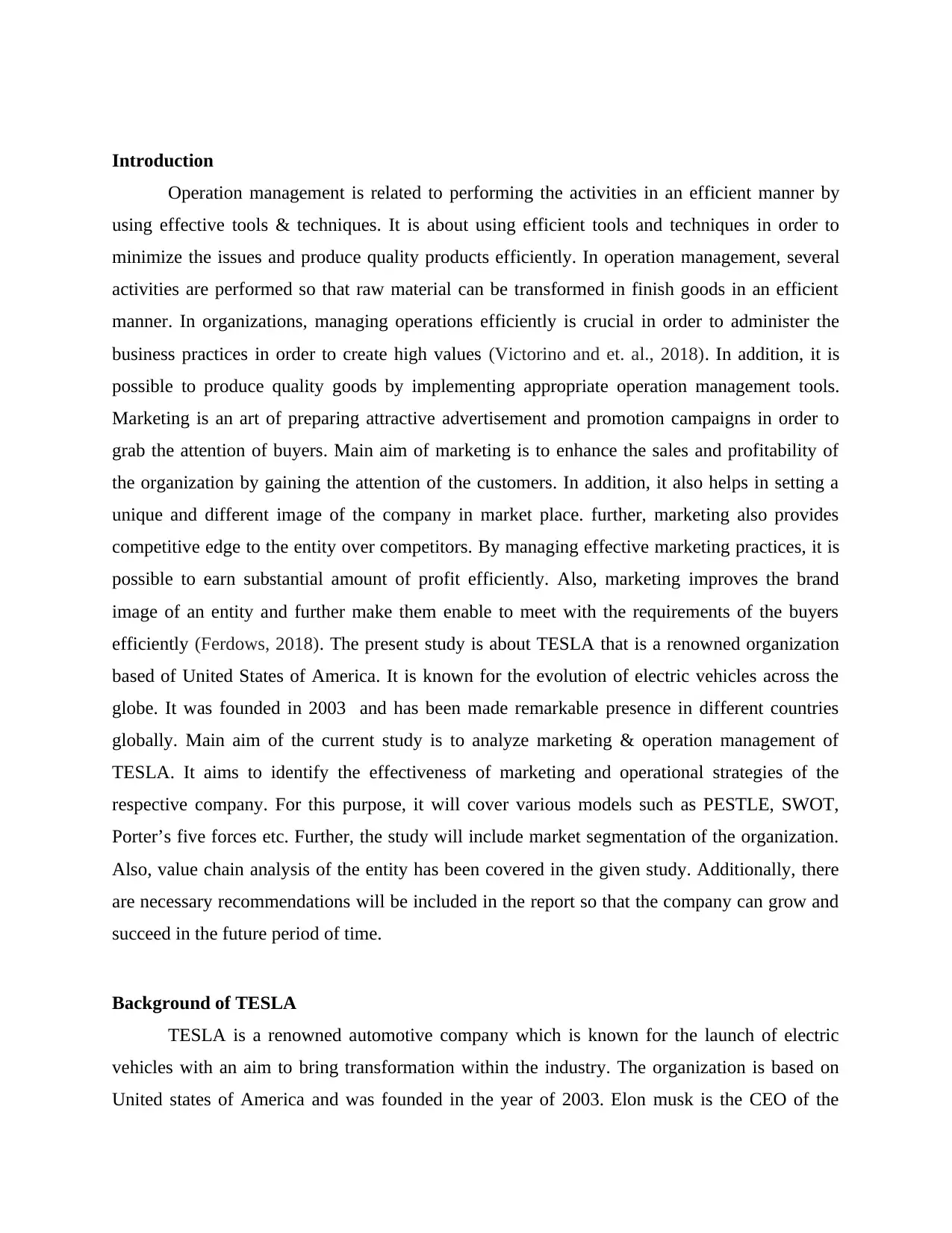
Introduction
Operation management is related to performing the activities in an efficient manner by
using effective tools & techniques. It is about using efficient tools and techniques in order to
minimize the issues and produce quality products efficiently. In operation management, several
activities are performed so that raw material can be transformed in finish goods in an efficient
manner. In organizations, managing operations efficiently is crucial in order to administer the
business practices in order to create high values (Victorino and et. al., 2018). In addition, it is
possible to produce quality goods by implementing appropriate operation management tools.
Marketing is an art of preparing attractive advertisement and promotion campaigns in order to
grab the attention of buyers. Main aim of marketing is to enhance the sales and profitability of
the organization by gaining the attention of the customers. In addition, it also helps in setting a
unique and different image of the company in market place. further, marketing also provides
competitive edge to the entity over competitors. By managing effective marketing practices, it is
possible to earn substantial amount of profit efficiently. Also, marketing improves the brand
image of an entity and further make them enable to meet with the requirements of the buyers
efficiently (Ferdows, 2018). The present study is about TESLA that is a renowned organization
based of United States of America. It is known for the evolution of electric vehicles across the
globe. It was founded in 2003 and has been made remarkable presence in different countries
globally. Main aim of the current study is to analyze marketing & operation management of
TESLA. It aims to identify the effectiveness of marketing and operational strategies of the
respective company. For this purpose, it will cover various models such as PESTLE, SWOT,
Porter’s five forces etc. Further, the study will include market segmentation of the organization.
Also, value chain analysis of the entity has been covered in the given study. Additionally, there
are necessary recommendations will be included in the report so that the company can grow and
succeed in the future period of time.
Background of TESLA
TESLA is a renowned automotive company which is known for the launch of electric
vehicles with an aim to bring transformation within the industry. The organization is based on
United states of America and was founded in the year of 2003. Elon musk is the CEO of the
Operation management is related to performing the activities in an efficient manner by
using effective tools & techniques. It is about using efficient tools and techniques in order to
minimize the issues and produce quality products efficiently. In operation management, several
activities are performed so that raw material can be transformed in finish goods in an efficient
manner. In organizations, managing operations efficiently is crucial in order to administer the
business practices in order to create high values (Victorino and et. al., 2018). In addition, it is
possible to produce quality goods by implementing appropriate operation management tools.
Marketing is an art of preparing attractive advertisement and promotion campaigns in order to
grab the attention of buyers. Main aim of marketing is to enhance the sales and profitability of
the organization by gaining the attention of the customers. In addition, it also helps in setting a
unique and different image of the company in market place. further, marketing also provides
competitive edge to the entity over competitors. By managing effective marketing practices, it is
possible to earn substantial amount of profit efficiently. Also, marketing improves the brand
image of an entity and further make them enable to meet with the requirements of the buyers
efficiently (Ferdows, 2018). The present study is about TESLA that is a renowned organization
based of United States of America. It is known for the evolution of electric vehicles across the
globe. It was founded in 2003 and has been made remarkable presence in different countries
globally. Main aim of the current study is to analyze marketing & operation management of
TESLA. It aims to identify the effectiveness of marketing and operational strategies of the
respective company. For this purpose, it will cover various models such as PESTLE, SWOT,
Porter’s five forces etc. Further, the study will include market segmentation of the organization.
Also, value chain analysis of the entity has been covered in the given study. Additionally, there
are necessary recommendations will be included in the report so that the company can grow and
succeed in the future period of time.
Background of TESLA
TESLA is a renowned automotive company which is known for the launch of electric
vehicles with an aim to bring transformation within the industry. The organization is based on
United states of America and was founded in the year of 2003. Elon musk is the CEO of the
Secure Best Marks with AI Grader
Need help grading? Try our AI Grader for instant feedback on your assignments.
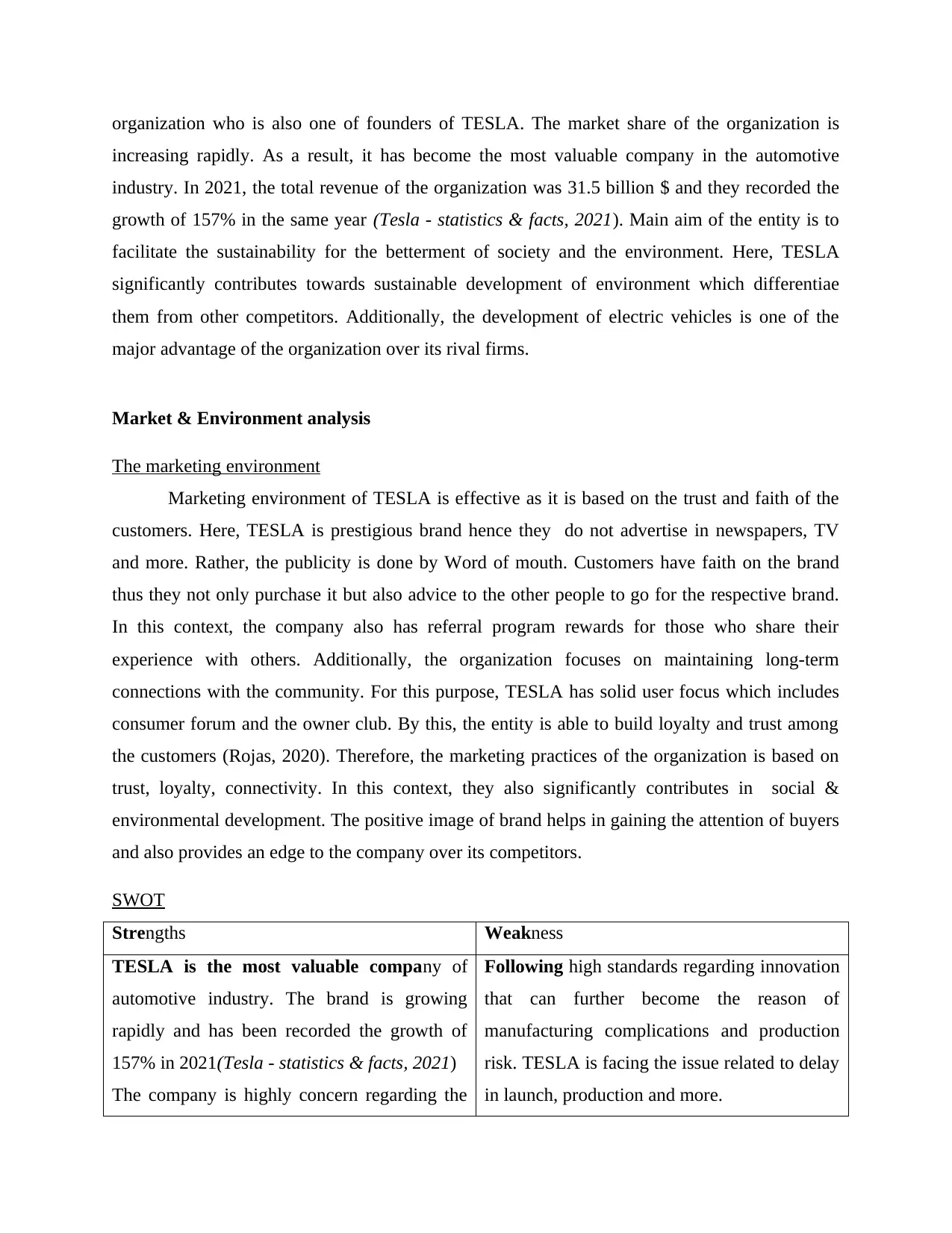
organization who is also one of founders of TESLA. The market share of the organization is
increasing rapidly. As a result, it has become the most valuable company in the automotive
industry. In 2021, the total revenue of the organization was 31.5 billion $ and they recorded the
growth of 157% in the same year (Tesla - statistics & facts, 2021). Main aim of the entity is to
facilitate the sustainability for the betterment of society and the environment. Here, TESLA
significantly contributes towards sustainable development of environment which differentiae
them from other competitors. Additionally, the development of electric vehicles is one of the
major advantage of the organization over its rival firms.
Market & Environment analysis
The marketing environment
Marketing environment of TESLA is effective as it is based on the trust and faith of the
customers. Here, TESLA is prestigious brand hence they do not advertise in newspapers, TV
and more. Rather, the publicity is done by Word of mouth. Customers have faith on the brand
thus they not only purchase it but also advice to the other people to go for the respective brand.
In this context, the company also has referral program rewards for those who share their
experience with others. Additionally, the organization focuses on maintaining long-term
connections with the community. For this purpose, TESLA has solid user focus which includes
consumer forum and the owner club. By this, the entity is able to build loyalty and trust among
the customers (Rojas, 2020). Therefore, the marketing practices of the organization is based on
trust, loyalty, connectivity. In this context, they also significantly contributes in social &
environmental development. The positive image of brand helps in gaining the attention of buyers
and also provides an edge to the company over its competitors.
SWOT
Strengths Weakness
TESLA is the most valuable company of
automotive industry. The brand is growing
rapidly and has been recorded the growth of
157% in 2021(Tesla - statistics & facts, 2021)
The company is highly concern regarding the
Following high standards regarding innovation
that can further become the reason of
manufacturing complications and production
risk. TESLA is facing the issue related to delay
in launch, production and more.
increasing rapidly. As a result, it has become the most valuable company in the automotive
industry. In 2021, the total revenue of the organization was 31.5 billion $ and they recorded the
growth of 157% in the same year (Tesla - statistics & facts, 2021). Main aim of the entity is to
facilitate the sustainability for the betterment of society and the environment. Here, TESLA
significantly contributes towards sustainable development of environment which differentiae
them from other competitors. Additionally, the development of electric vehicles is one of the
major advantage of the organization over its rival firms.
Market & Environment analysis
The marketing environment
Marketing environment of TESLA is effective as it is based on the trust and faith of the
customers. Here, TESLA is prestigious brand hence they do not advertise in newspapers, TV
and more. Rather, the publicity is done by Word of mouth. Customers have faith on the brand
thus they not only purchase it but also advice to the other people to go for the respective brand.
In this context, the company also has referral program rewards for those who share their
experience with others. Additionally, the organization focuses on maintaining long-term
connections with the community. For this purpose, TESLA has solid user focus which includes
consumer forum and the owner club. By this, the entity is able to build loyalty and trust among
the customers (Rojas, 2020). Therefore, the marketing practices of the organization is based on
trust, loyalty, connectivity. In this context, they also significantly contributes in social &
environmental development. The positive image of brand helps in gaining the attention of buyers
and also provides an edge to the company over its competitors.
SWOT
Strengths Weakness
TESLA is the most valuable company of
automotive industry. The brand is growing
rapidly and has been recorded the growth of
157% in 2021(Tesla - statistics & facts, 2021)
The company is highly concern regarding the
Following high standards regarding innovation
that can further become the reason of
manufacturing complications and production
risk. TESLA is facing the issue related to delay
in launch, production and more.
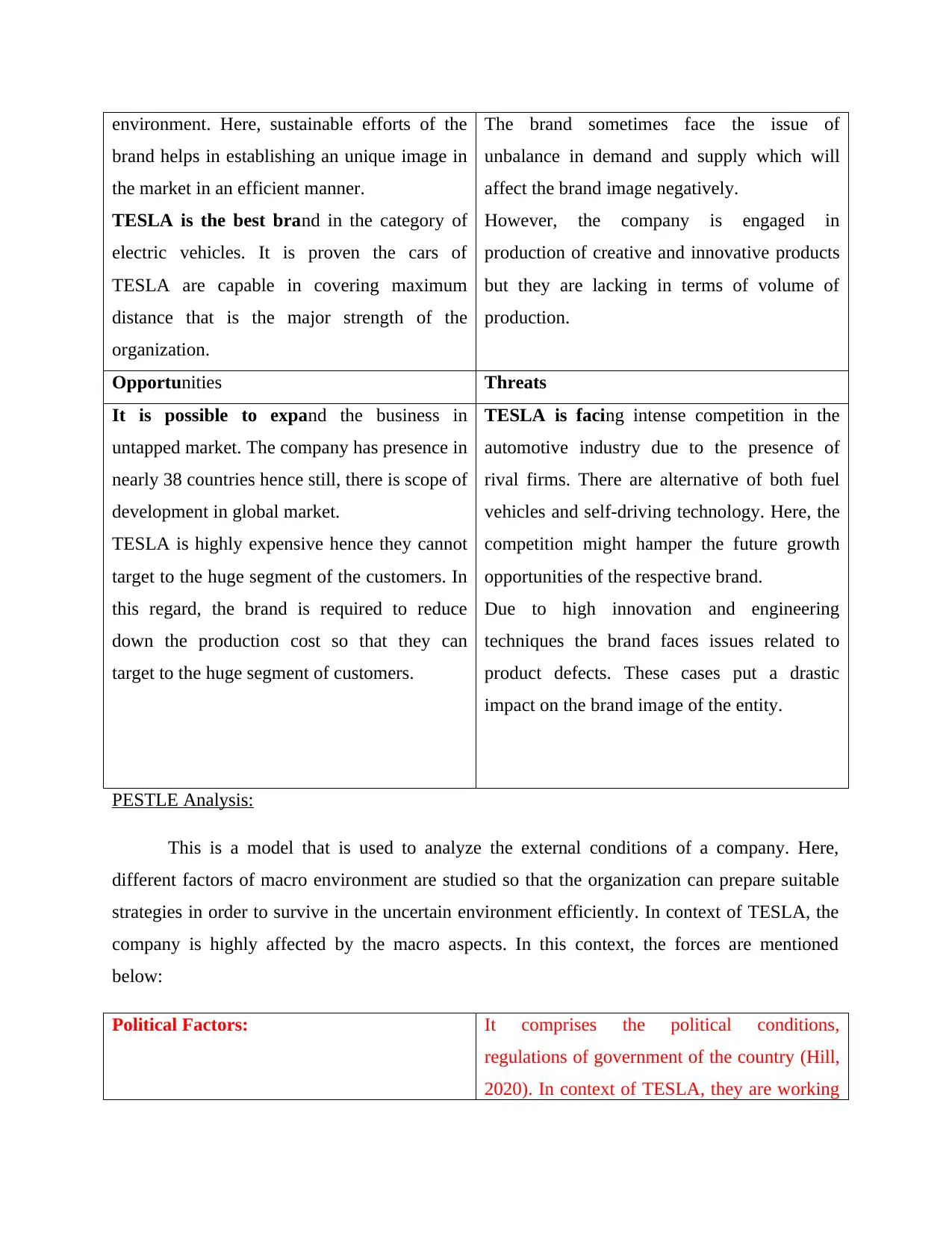
environment. Here, sustainable efforts of the
brand helps in establishing an unique image in
the market in an efficient manner.
TESLA is the best brand in the category of
electric vehicles. It is proven the cars of
TESLA are capable in covering maximum
distance that is the major strength of the
organization.
The brand sometimes face the issue of
unbalance in demand and supply which will
affect the brand image negatively.
However, the company is engaged in
production of creative and innovative products
but they are lacking in terms of volume of
production.
Opportunities Threats
It is possible to expand the business in
untapped market. The company has presence in
nearly 38 countries hence still, there is scope of
development in global market.
TESLA is highly expensive hence they cannot
target to the huge segment of the customers. In
this regard, the brand is required to reduce
down the production cost so that they can
target to the huge segment of customers.
TESLA is facing intense competition in the
automotive industry due to the presence of
rival firms. There are alternative of both fuel
vehicles and self-driving technology. Here, the
competition might hamper the future growth
opportunities of the respective brand.
Due to high innovation and engineering
techniques the brand faces issues related to
product defects. These cases put a drastic
impact on the brand image of the entity.
PESTLE Analysis:
This is a model that is used to analyze the external conditions of a company. Here,
different factors of macro environment are studied so that the organization can prepare suitable
strategies in order to survive in the uncertain environment efficiently. In context of TESLA, the
company is highly affected by the macro aspects. In this context, the forces are mentioned
below:
Political Factors: It comprises the political conditions,
regulations of government of the country (Hill,
2020). In context of TESLA, they are working
brand helps in establishing an unique image in
the market in an efficient manner.
TESLA is the best brand in the category of
electric vehicles. It is proven the cars of
TESLA are capable in covering maximum
distance that is the major strength of the
organization.
The brand sometimes face the issue of
unbalance in demand and supply which will
affect the brand image negatively.
However, the company is engaged in
production of creative and innovative products
but they are lacking in terms of volume of
production.
Opportunities Threats
It is possible to expand the business in
untapped market. The company has presence in
nearly 38 countries hence still, there is scope of
development in global market.
TESLA is highly expensive hence they cannot
target to the huge segment of the customers. In
this regard, the brand is required to reduce
down the production cost so that they can
target to the huge segment of customers.
TESLA is facing intense competition in the
automotive industry due to the presence of
rival firms. There are alternative of both fuel
vehicles and self-driving technology. Here, the
competition might hamper the future growth
opportunities of the respective brand.
Due to high innovation and engineering
techniques the brand faces issues related to
product defects. These cases put a drastic
impact on the brand image of the entity.
PESTLE Analysis:
This is a model that is used to analyze the external conditions of a company. Here,
different factors of macro environment are studied so that the organization can prepare suitable
strategies in order to survive in the uncertain environment efficiently. In context of TESLA, the
company is highly affected by the macro aspects. In this context, the forces are mentioned
below:
Political Factors: It comprises the political conditions,
regulations of government of the country (Hill,
2020). In context of TESLA, they are working
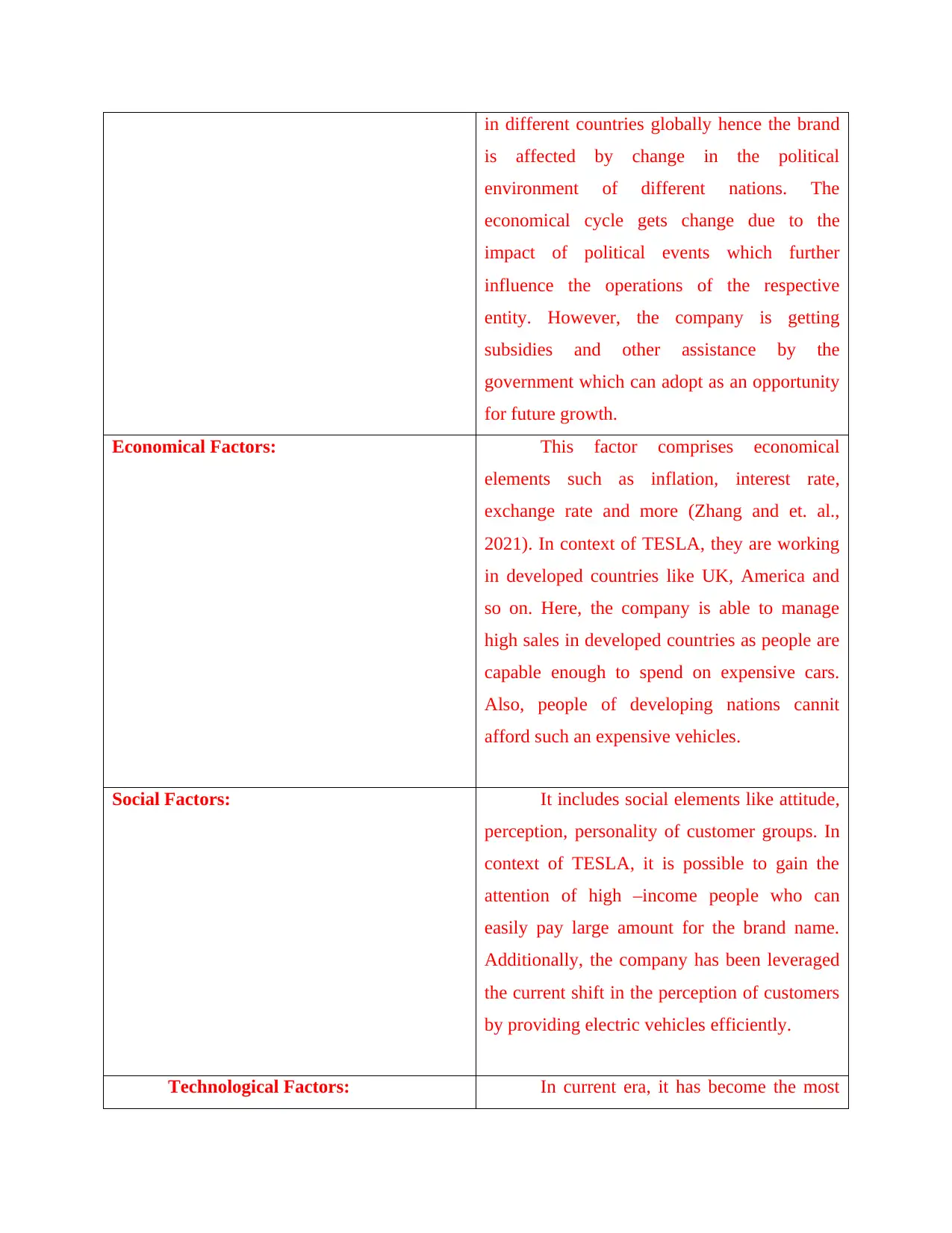
in different countries globally hence the brand
is affected by change in the political
environment of different nations. The
economical cycle gets change due to the
impact of political events which further
influence the operations of the respective
entity. However, the company is getting
subsidies and other assistance by the
government which can adopt as an opportunity
for future growth.
Economical Factors: This factor comprises economical
elements such as inflation, interest rate,
exchange rate and more (Zhang and et. al.,
2021). In context of TESLA, they are working
in developed countries like UK, America and
so on. Here, the company is able to manage
high sales in developed countries as people are
capable enough to spend on expensive cars.
Also, people of developing nations cannit
afford such an expensive vehicles.
Social Factors: It includes social elements like attitude,
perception, personality of customer groups. In
context of TESLA, it is possible to gain the
attention of high –income people who can
easily pay large amount for the brand name.
Additionally, the company has been leveraged
the current shift in the perception of customers
by providing electric vehicles efficiently.
Technological Factors: In current era, it has become the most
is affected by change in the political
environment of different nations. The
economical cycle gets change due to the
impact of political events which further
influence the operations of the respective
entity. However, the company is getting
subsidies and other assistance by the
government which can adopt as an opportunity
for future growth.
Economical Factors: This factor comprises economical
elements such as inflation, interest rate,
exchange rate and more (Zhang and et. al.,
2021). In context of TESLA, they are working
in developed countries like UK, America and
so on. Here, the company is able to manage
high sales in developed countries as people are
capable enough to spend on expensive cars.
Also, people of developing nations cannit
afford such an expensive vehicles.
Social Factors: It includes social elements like attitude,
perception, personality of customer groups. In
context of TESLA, it is possible to gain the
attention of high –income people who can
easily pay large amount for the brand name.
Additionally, the company has been leveraged
the current shift in the perception of customers
by providing electric vehicles efficiently.
Technological Factors: In current era, it has become the most
Paraphrase This Document
Need a fresh take? Get an instant paraphrase of this document with our AI Paraphraser
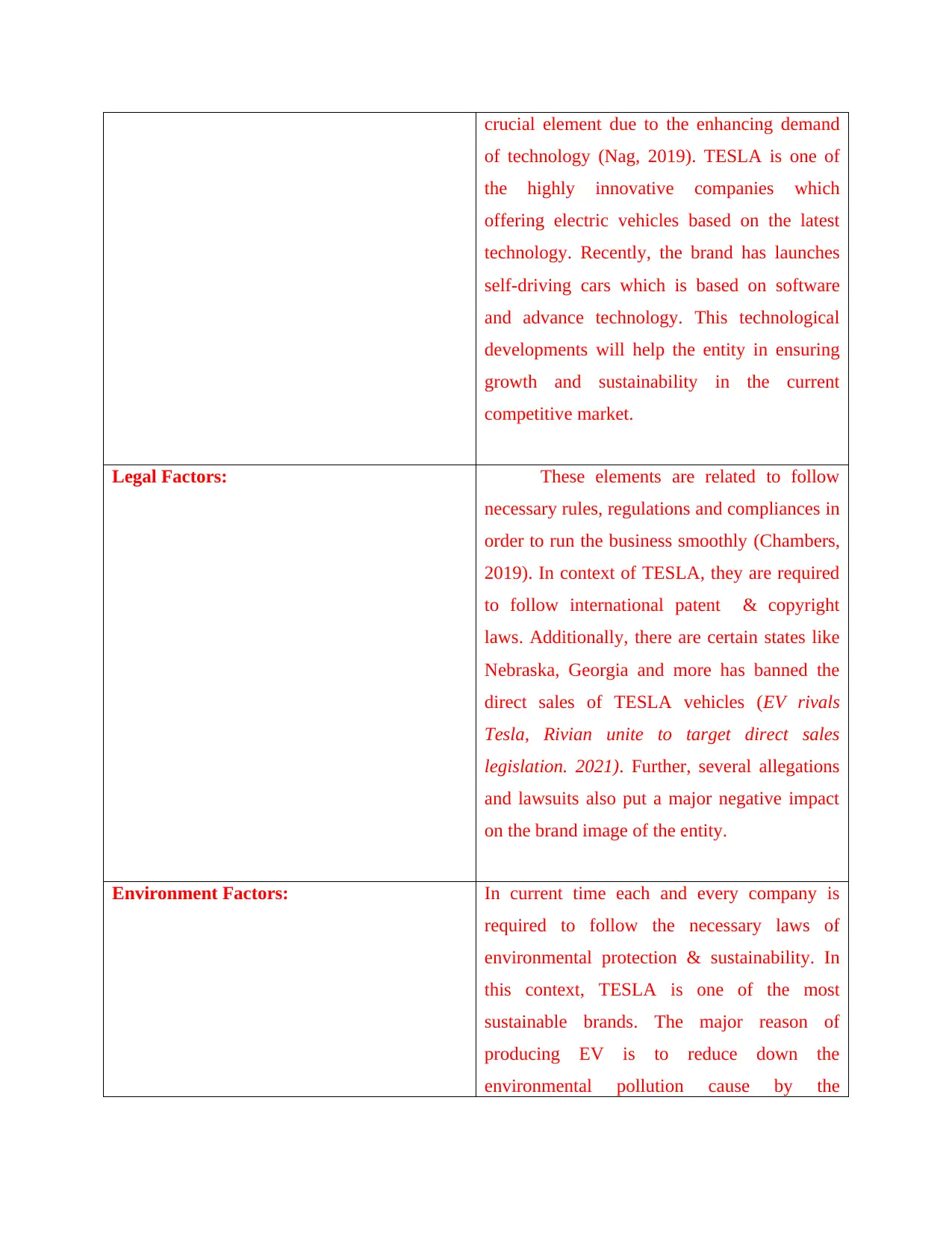
crucial element due to the enhancing demand
of technology (Nag, 2019). TESLA is one of
the highly innovative companies which
offering electric vehicles based on the latest
technology. Recently, the brand has launches
self-driving cars which is based on software
and advance technology. This technological
developments will help the entity in ensuring
growth and sustainability in the current
competitive market.
Legal Factors: These elements are related to follow
necessary rules, regulations and compliances in
order to run the business smoothly (Chambers,
2019). In context of TESLA, they are required
to follow international patent & copyright
laws. Additionally, there are certain states like
Nebraska, Georgia and more has banned the
direct sales of TESLA vehicles (EV rivals
Tesla, Rivian unite to target direct sales
legislation. 2021). Further, several allegations
and lawsuits also put a major negative impact
on the brand image of the entity.
Environment Factors: In current time each and every company is
required to follow the necessary laws of
environmental protection & sustainability. In
this context, TESLA is one of the most
sustainable brands. The major reason of
producing EV is to reduce down the
environmental pollution cause by the
of technology (Nag, 2019). TESLA is one of
the highly innovative companies which
offering electric vehicles based on the latest
technology. Recently, the brand has launches
self-driving cars which is based on software
and advance technology. This technological
developments will help the entity in ensuring
growth and sustainability in the current
competitive market.
Legal Factors: These elements are related to follow
necessary rules, regulations and compliances in
order to run the business smoothly (Chambers,
2019). In context of TESLA, they are required
to follow international patent & copyright
laws. Additionally, there are certain states like
Nebraska, Georgia and more has banned the
direct sales of TESLA vehicles (EV rivals
Tesla, Rivian unite to target direct sales
legislation. 2021). Further, several allegations
and lawsuits also put a major negative impact
on the brand image of the entity.
Environment Factors: In current time each and every company is
required to follow the necessary laws of
environmental protection & sustainability. In
this context, TESLA is one of the most
sustainable brands. The major reason of
producing EV is to reduce down the
environmental pollution cause by the
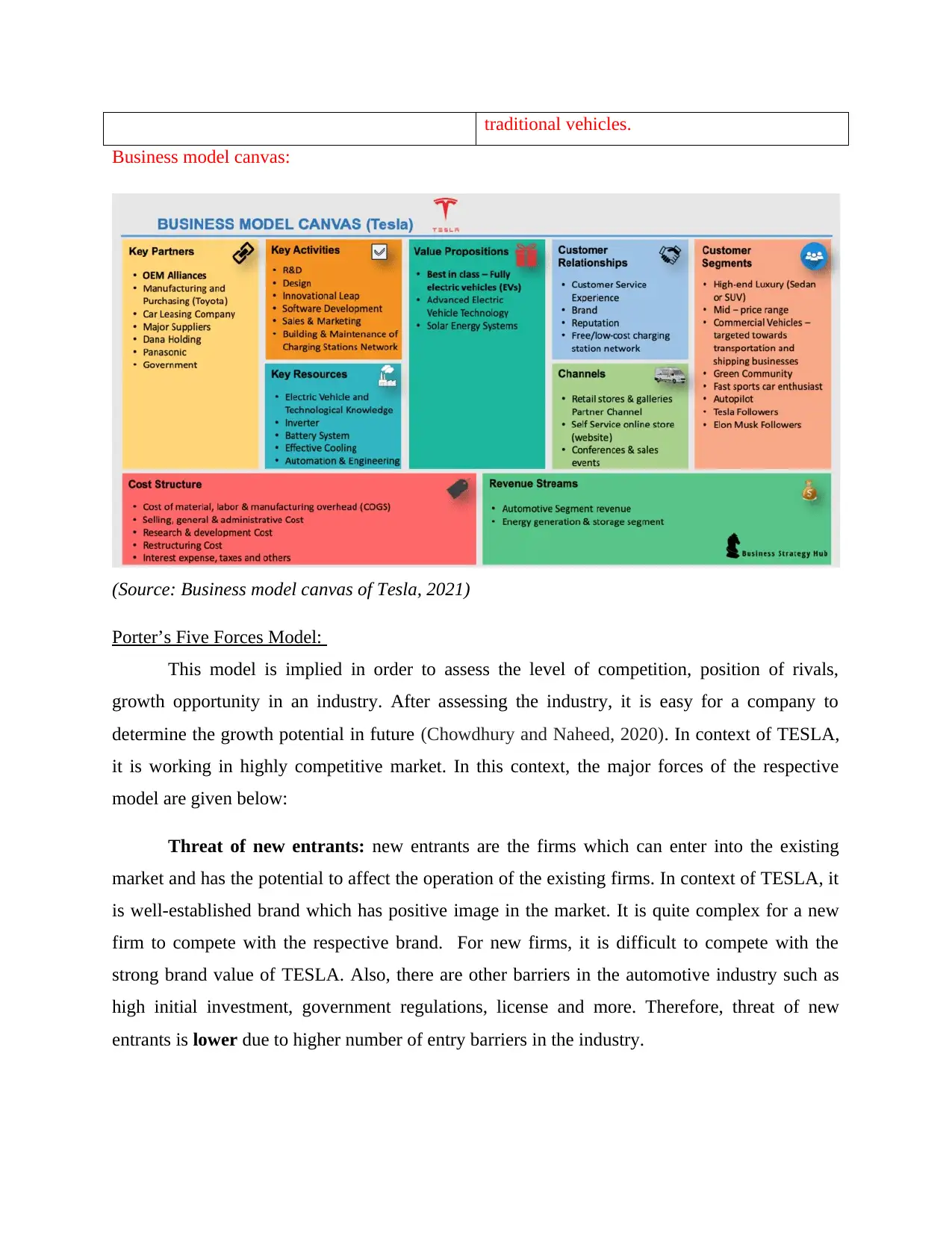
traditional vehicles.
Business model canvas:
(Source: Business model canvas of Tesla, 2021)
Porter’s Five Forces Model:
This model is implied in order to assess the level of competition, position of rivals,
growth opportunity in an industry. After assessing the industry, it is easy for a company to
determine the growth potential in future (Chowdhury and Naheed, 2020). In context of TESLA,
it is working in highly competitive market. In this context, the major forces of the respective
model are given below:
Threat of new entrants: new entrants are the firms which can enter into the existing
market and has the potential to affect the operation of the existing firms. In context of TESLA, it
is well-established brand which has positive image in the market. It is quite complex for a new
firm to compete with the respective brand. For new firms, it is difficult to compete with the
strong brand value of TESLA. Also, there are other barriers in the automotive industry such as
high initial investment, government regulations, license and more. Therefore, threat of new
entrants is lower due to higher number of entry barriers in the industry.
Business model canvas:
(Source: Business model canvas of Tesla, 2021)
Porter’s Five Forces Model:
This model is implied in order to assess the level of competition, position of rivals,
growth opportunity in an industry. After assessing the industry, it is easy for a company to
determine the growth potential in future (Chowdhury and Naheed, 2020). In context of TESLA,
it is working in highly competitive market. In this context, the major forces of the respective
model are given below:
Threat of new entrants: new entrants are the firms which can enter into the existing
market and has the potential to affect the operation of the existing firms. In context of TESLA, it
is well-established brand which has positive image in the market. It is quite complex for a new
firm to compete with the respective brand. For new firms, it is difficult to compete with the
strong brand value of TESLA. Also, there are other barriers in the automotive industry such as
high initial investment, government regulations, license and more. Therefore, threat of new
entrants is lower due to higher number of entry barriers in the industry.
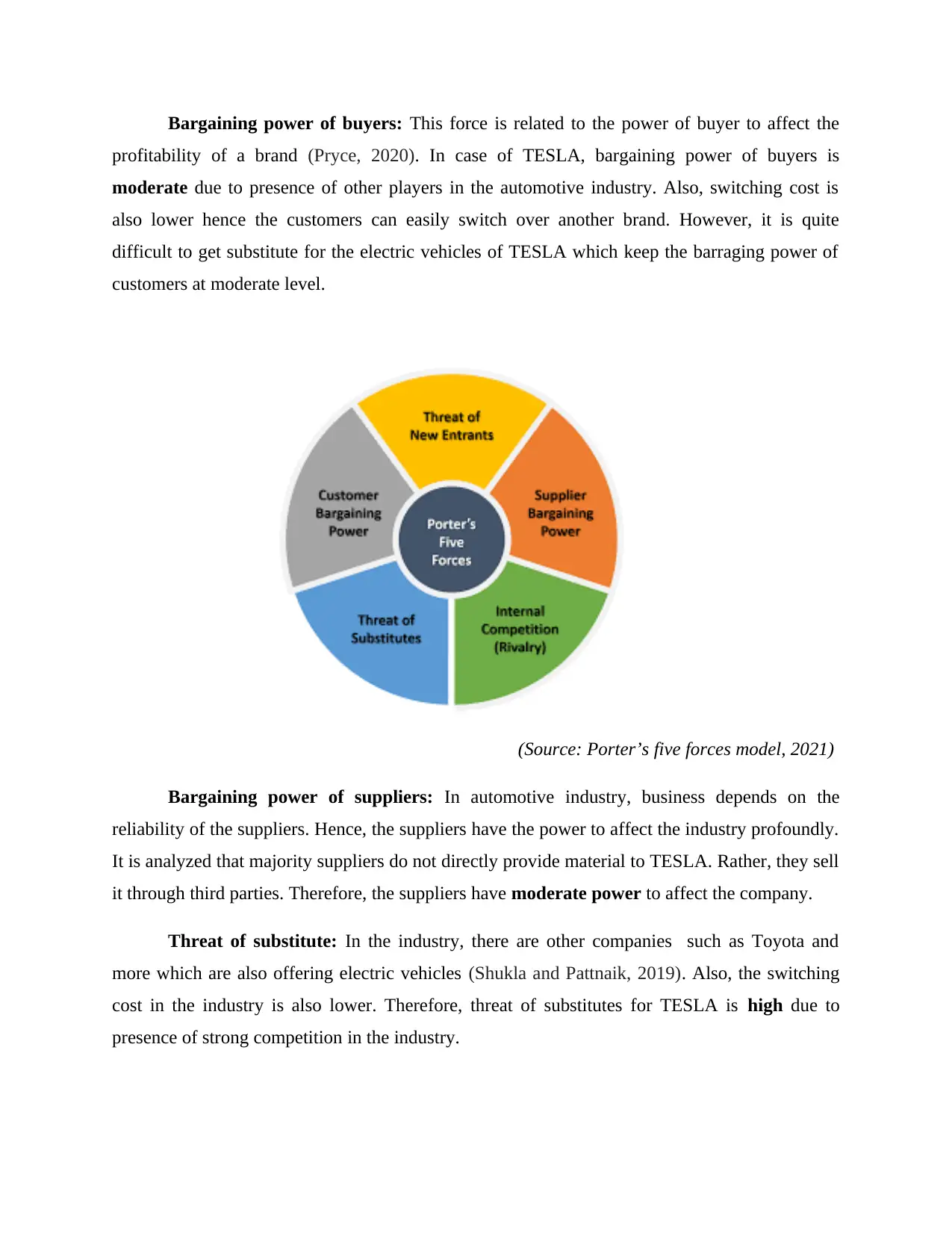
Bargaining power of buyers: This force is related to the power of buyer to affect the
profitability of a brand (Pryce, 2020). In case of TESLA, bargaining power of buyers is
moderate due to presence of other players in the automotive industry. Also, switching cost is
also lower hence the customers can easily switch over another brand. However, it is quite
difficult to get substitute for the electric vehicles of TESLA which keep the barraging power of
customers at moderate level.
(Source: Porter’s five forces model, 2021)
Bargaining power of suppliers: In automotive industry, business depends on the
reliability of the suppliers. Hence, the suppliers have the power to affect the industry profoundly.
It is analyzed that majority suppliers do not directly provide material to TESLA. Rather, they sell
it through third parties. Therefore, the suppliers have moderate power to affect the company.
Threat of substitute: In the industry, there are other companies such as Toyota and
more which are also offering electric vehicles (Shukla and Pattnaik, 2019). Also, the switching
cost in the industry is also lower. Therefore, threat of substitutes for TESLA is high due to
presence of strong competition in the industry.
profitability of a brand (Pryce, 2020). In case of TESLA, bargaining power of buyers is
moderate due to presence of other players in the automotive industry. Also, switching cost is
also lower hence the customers can easily switch over another brand. However, it is quite
difficult to get substitute for the electric vehicles of TESLA which keep the barraging power of
customers at moderate level.
(Source: Porter’s five forces model, 2021)
Bargaining power of suppliers: In automotive industry, business depends on the
reliability of the suppliers. Hence, the suppliers have the power to affect the industry profoundly.
It is analyzed that majority suppliers do not directly provide material to TESLA. Rather, they sell
it through third parties. Therefore, the suppliers have moderate power to affect the company.
Threat of substitute: In the industry, there are other companies such as Toyota and
more which are also offering electric vehicles (Shukla and Pattnaik, 2019). Also, the switching
cost in the industry is also lower. Therefore, threat of substitutes for TESLA is high due to
presence of strong competition in the industry.
Secure Best Marks with AI Grader
Need help grading? Try our AI Grader for instant feedback on your assignments.
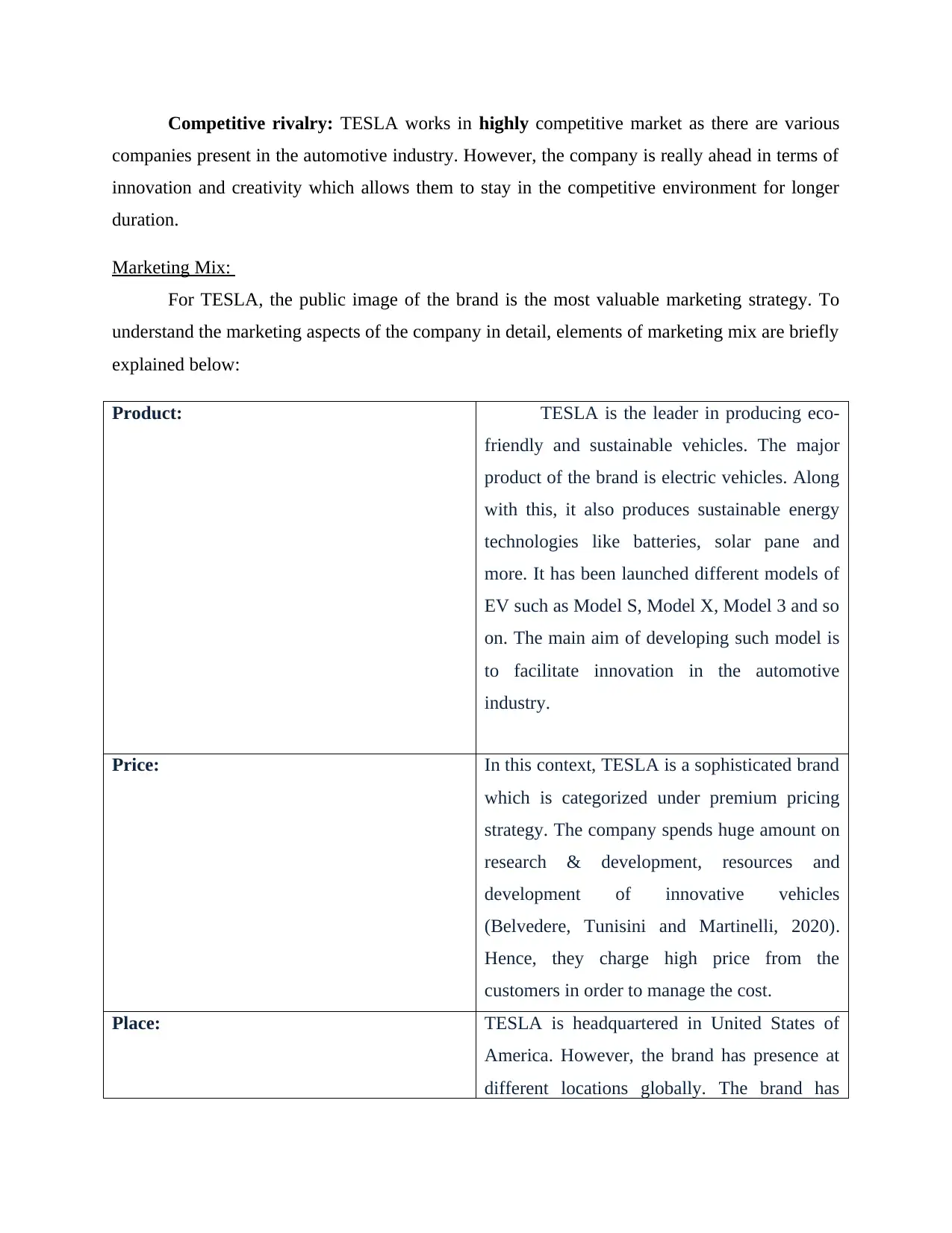
Competitive rivalry: TESLA works in highly competitive market as there are various
companies present in the automotive industry. However, the company is really ahead in terms of
innovation and creativity which allows them to stay in the competitive environment for longer
duration.
Marketing Mix:
For TESLA, the public image of the brand is the most valuable marketing strategy. To
understand the marketing aspects of the company in detail, elements of marketing mix are briefly
explained below:
Product: TESLA is the leader in producing eco-
friendly and sustainable vehicles. The major
product of the brand is electric vehicles. Along
with this, it also produces sustainable energy
technologies like batteries, solar pane and
more. It has been launched different models of
EV such as Model S, Model X, Model 3 and so
on. The main aim of developing such model is
to facilitate innovation in the automotive
industry.
Price: In this context, TESLA is a sophisticated brand
which is categorized under premium pricing
strategy. The company spends huge amount on
research & development, resources and
development of innovative vehicles
(Belvedere, Tunisini and Martinelli, 2020).
Hence, they charge high price from the
customers in order to manage the cost.
Place: TESLA is headquartered in United States of
America. However, the brand has presence at
different locations globally. The brand has
companies present in the automotive industry. However, the company is really ahead in terms of
innovation and creativity which allows them to stay in the competitive environment for longer
duration.
Marketing Mix:
For TESLA, the public image of the brand is the most valuable marketing strategy. To
understand the marketing aspects of the company in detail, elements of marketing mix are briefly
explained below:
Product: TESLA is the leader in producing eco-
friendly and sustainable vehicles. The major
product of the brand is electric vehicles. Along
with this, it also produces sustainable energy
technologies like batteries, solar pane and
more. It has been launched different models of
EV such as Model S, Model X, Model 3 and so
on. The main aim of developing such model is
to facilitate innovation in the automotive
industry.
Price: In this context, TESLA is a sophisticated brand
which is categorized under premium pricing
strategy. The company spends huge amount on
research & development, resources and
development of innovative vehicles
(Belvedere, Tunisini and Martinelli, 2020).
Hence, they charge high price from the
customers in order to manage the cost.
Place: TESLA is headquartered in United States of
America. However, the brand has presence at
different locations globally. The brand has
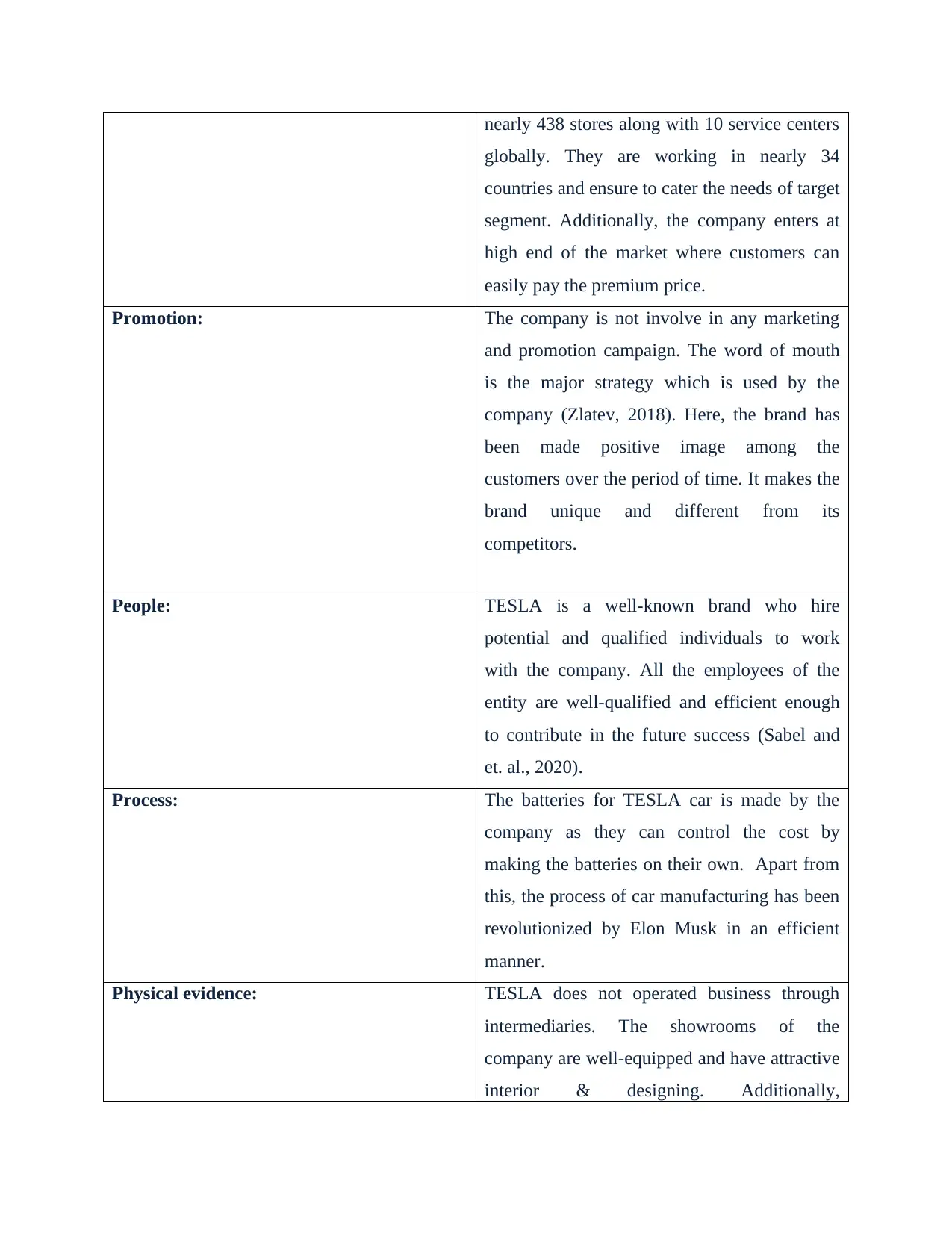
nearly 438 stores along with 10 service centers
globally. They are working in nearly 34
countries and ensure to cater the needs of target
segment. Additionally, the company enters at
high end of the market where customers can
easily pay the premium price.
Promotion: The company is not involve in any marketing
and promotion campaign. The word of mouth
is the major strategy which is used by the
company (Zlatev, 2018). Here, the brand has
been made positive image among the
customers over the period of time. It makes the
brand unique and different from its
competitors.
People: TESLA is a well-known brand who hire
potential and qualified individuals to work
with the company. All the employees of the
entity are well-qualified and efficient enough
to contribute in the future success (Sabel and
et. al., 2020).
Process: The batteries for TESLA car is made by the
company as they can control the cost by
making the batteries on their own. Apart from
this, the process of car manufacturing has been
revolutionized by Elon Musk in an efficient
manner.
Physical evidence: TESLA does not operated business through
intermediaries. The showrooms of the
company are well-equipped and have attractive
interior & designing. Additionally,
globally. They are working in nearly 34
countries and ensure to cater the needs of target
segment. Additionally, the company enters at
high end of the market where customers can
easily pay the premium price.
Promotion: The company is not involve in any marketing
and promotion campaign. The word of mouth
is the major strategy which is used by the
company (Zlatev, 2018). Here, the brand has
been made positive image among the
customers over the period of time. It makes the
brand unique and different from its
competitors.
People: TESLA is a well-known brand who hire
potential and qualified individuals to work
with the company. All the employees of the
entity are well-qualified and efficient enough
to contribute in the future success (Sabel and
et. al., 2020).
Process: The batteries for TESLA car is made by the
company as they can control the cost by
making the batteries on their own. Apart from
this, the process of car manufacturing has been
revolutionized by Elon Musk in an efficient
manner.
Physical evidence: TESLA does not operated business through
intermediaries. The showrooms of the
company are well-equipped and have attractive
interior & designing. Additionally,
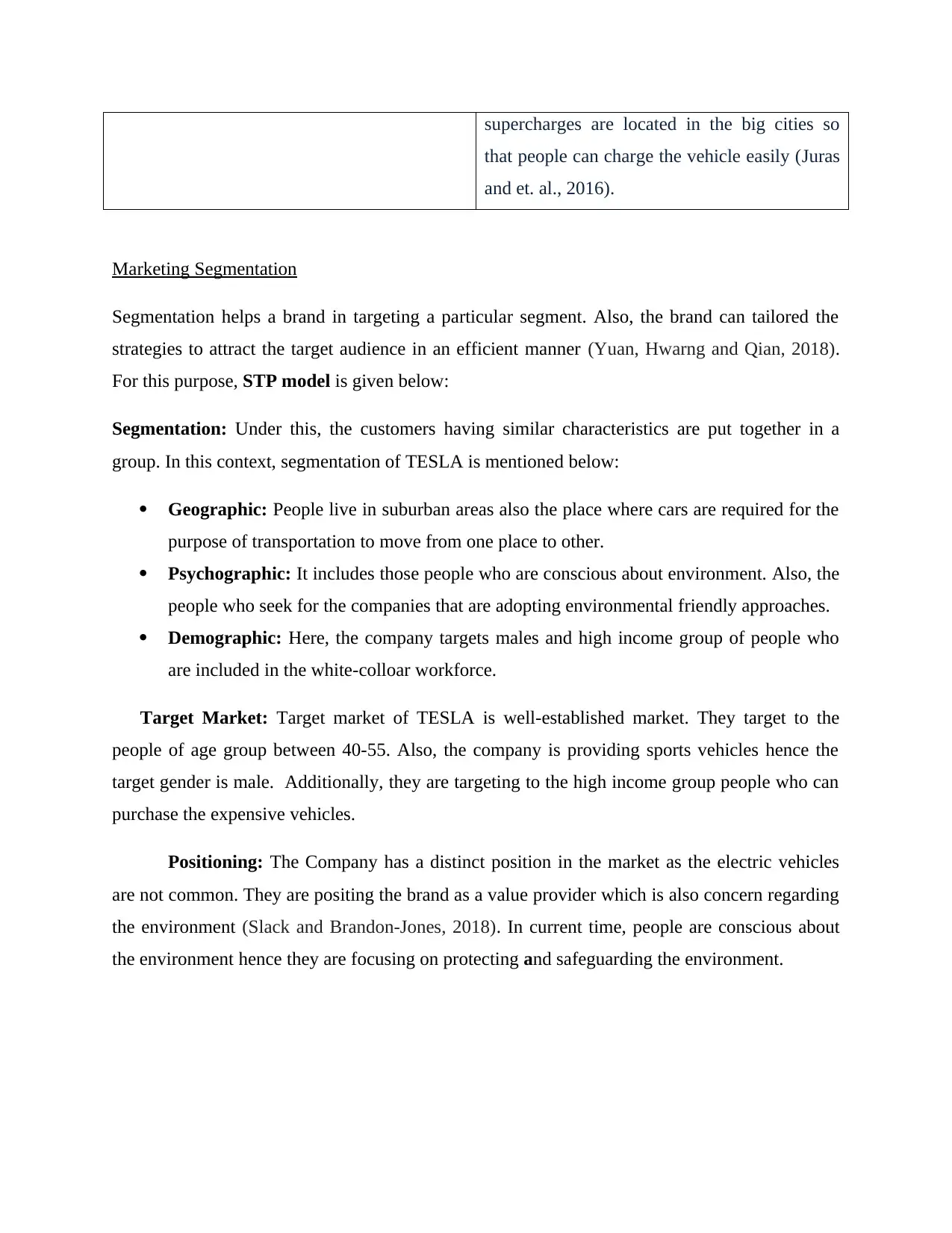
supercharges are located in the big cities so
that people can charge the vehicle easily (Juras
and et. al., 2016).
Marketing Segmentation
Segmentation helps a brand in targeting a particular segment. Also, the brand can tailored the
strategies to attract the target audience in an efficient manner (Yuan, Hwarng and Qian, 2018).
For this purpose, STP model is given below:
Segmentation: Under this, the customers having similar characteristics are put together in a
group. In this context, segmentation of TESLA is mentioned below:
Geographic: People live in suburban areas also the place where cars are required for the
purpose of transportation to move from one place to other.
Psychographic: It includes those people who are conscious about environment. Also, the
people who seek for the companies that are adopting environmental friendly approaches.
Demographic: Here, the company targets males and high income group of people who
are included in the white-colloar workforce.
Target Market: Target market of TESLA is well-established market. They target to the
people of age group between 40-55. Also, the company is providing sports vehicles hence the
target gender is male. Additionally, they are targeting to the high income group people who can
purchase the expensive vehicles.
Positioning: The Company has a distinct position in the market as the electric vehicles
are not common. They are positing the brand as a value provider which is also concern regarding
the environment (Slack and Brandon-Jones, 2018). In current time, people are conscious about
the environment hence they are focusing on protecting and safeguarding the environment.
that people can charge the vehicle easily (Juras
and et. al., 2016).
Marketing Segmentation
Segmentation helps a brand in targeting a particular segment. Also, the brand can tailored the
strategies to attract the target audience in an efficient manner (Yuan, Hwarng and Qian, 2018).
For this purpose, STP model is given below:
Segmentation: Under this, the customers having similar characteristics are put together in a
group. In this context, segmentation of TESLA is mentioned below:
Geographic: People live in suburban areas also the place where cars are required for the
purpose of transportation to move from one place to other.
Psychographic: It includes those people who are conscious about environment. Also, the
people who seek for the companies that are adopting environmental friendly approaches.
Demographic: Here, the company targets males and high income group of people who
are included in the white-colloar workforce.
Target Market: Target market of TESLA is well-established market. They target to the
people of age group between 40-55. Also, the company is providing sports vehicles hence the
target gender is male. Additionally, they are targeting to the high income group people who can
purchase the expensive vehicles.
Positioning: The Company has a distinct position in the market as the electric vehicles
are not common. They are positing the brand as a value provider which is also concern regarding
the environment (Slack and Brandon-Jones, 2018). In current time, people are conscious about
the environment hence they are focusing on protecting and safeguarding the environment.
Paraphrase This Document
Need a fresh take? Get an instant paraphrase of this document with our AI Paraphraser
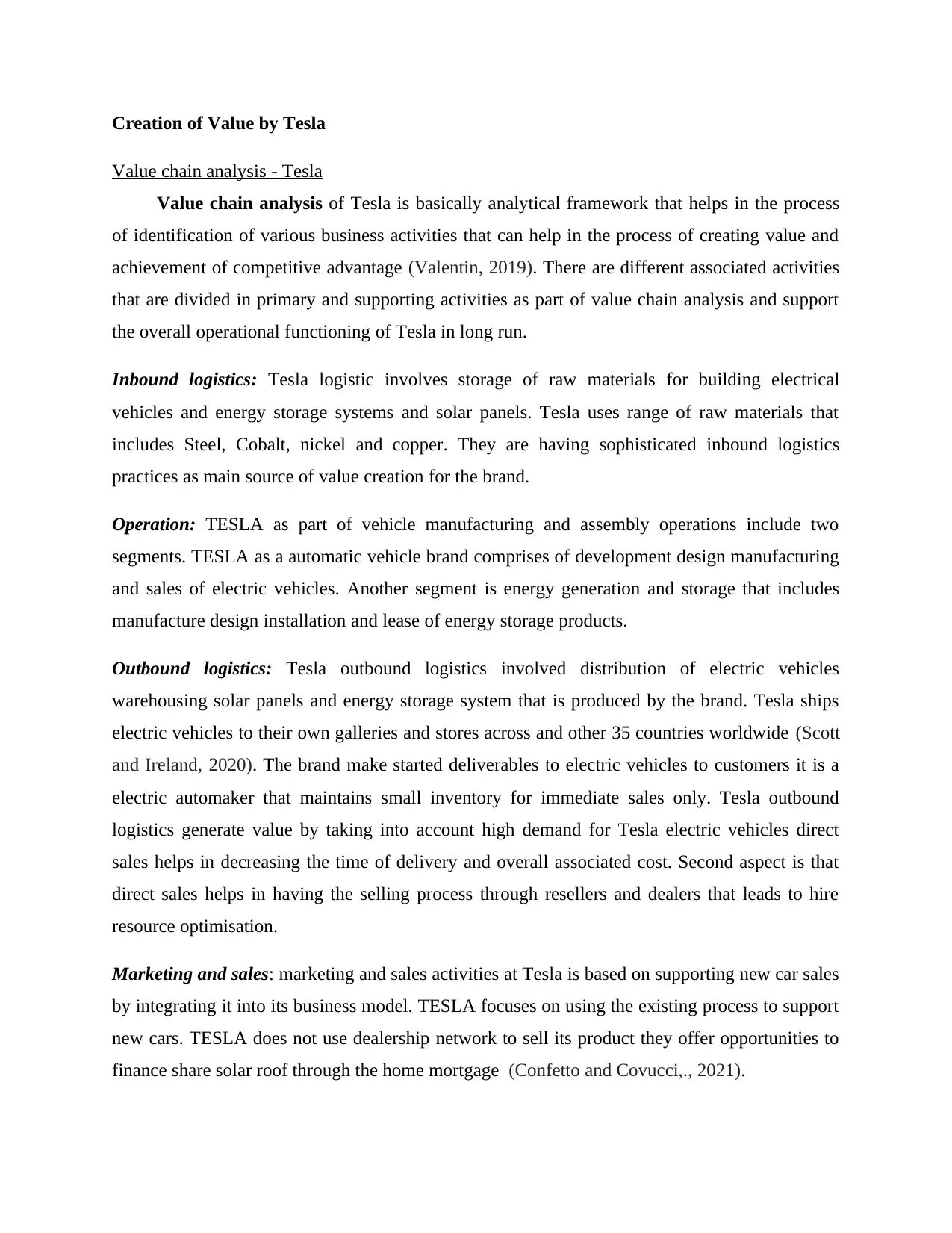
Creation of Value by Tesla
Value chain analysis - Tesla
Value chain analysis of Tesla is basically analytical framework that helps in the process
of identification of various business activities that can help in the process of creating value and
achievement of competitive advantage (Valentin, 2019). There are different associated activities
that are divided in primary and supporting activities as part of value chain analysis and support
the overall operational functioning of Tesla in long run.
Inbound logistics: Tesla logistic involves storage of raw materials for building electrical
vehicles and energy storage systems and solar panels. Tesla uses range of raw materials that
includes Steel, Cobalt, nickel and copper. They are having sophisticated inbound logistics
practices as main source of value creation for the brand.
Operation: TESLA as part of vehicle manufacturing and assembly operations include two
segments. TESLA as a automatic vehicle brand comprises of development design manufacturing
and sales of electric vehicles. Another segment is energy generation and storage that includes
manufacture design installation and lease of energy storage products.
Outbound logistics: Tesla outbound logistics involved distribution of electric vehicles
warehousing solar panels and energy storage system that is produced by the brand. Tesla ships
electric vehicles to their own galleries and stores across and other 35 countries worldwide (Scott
and Ireland, 2020). The brand make started deliverables to electric vehicles to customers it is a
electric automaker that maintains small inventory for immediate sales only. Tesla outbound
logistics generate value by taking into account high demand for Tesla electric vehicles direct
sales helps in decreasing the time of delivery and overall associated cost. Second aspect is that
direct sales helps in having the selling process through resellers and dealers that leads to hire
resource optimisation.
Marketing and sales: marketing and sales activities at Tesla is based on supporting new car sales
by integrating it into its business model. TESLA focuses on using the existing process to support
new cars. TESLA does not use dealership network to sell its product they offer opportunities to
finance share solar roof through the home mortgage (Confetto and Covucci,., 2021).
Value chain analysis - Tesla
Value chain analysis of Tesla is basically analytical framework that helps in the process
of identification of various business activities that can help in the process of creating value and
achievement of competitive advantage (Valentin, 2019). There are different associated activities
that are divided in primary and supporting activities as part of value chain analysis and support
the overall operational functioning of Tesla in long run.
Inbound logistics: Tesla logistic involves storage of raw materials for building electrical
vehicles and energy storage systems and solar panels. Tesla uses range of raw materials that
includes Steel, Cobalt, nickel and copper. They are having sophisticated inbound logistics
practices as main source of value creation for the brand.
Operation: TESLA as part of vehicle manufacturing and assembly operations include two
segments. TESLA as a automatic vehicle brand comprises of development design manufacturing
and sales of electric vehicles. Another segment is energy generation and storage that includes
manufacture design installation and lease of energy storage products.
Outbound logistics: Tesla outbound logistics involved distribution of electric vehicles
warehousing solar panels and energy storage system that is produced by the brand. Tesla ships
electric vehicles to their own galleries and stores across and other 35 countries worldwide (Scott
and Ireland, 2020). The brand make started deliverables to electric vehicles to customers it is a
electric automaker that maintains small inventory for immediate sales only. Tesla outbound
logistics generate value by taking into account high demand for Tesla electric vehicles direct
sales helps in decreasing the time of delivery and overall associated cost. Second aspect is that
direct sales helps in having the selling process through resellers and dealers that leads to hire
resource optimisation.
Marketing and sales: marketing and sales activities at Tesla is based on supporting new car sales
by integrating it into its business model. TESLA focuses on using the existing process to support
new cars. TESLA does not use dealership network to sell its product they offer opportunities to
finance share solar roof through the home mortgage (Confetto and Covucci,., 2021).
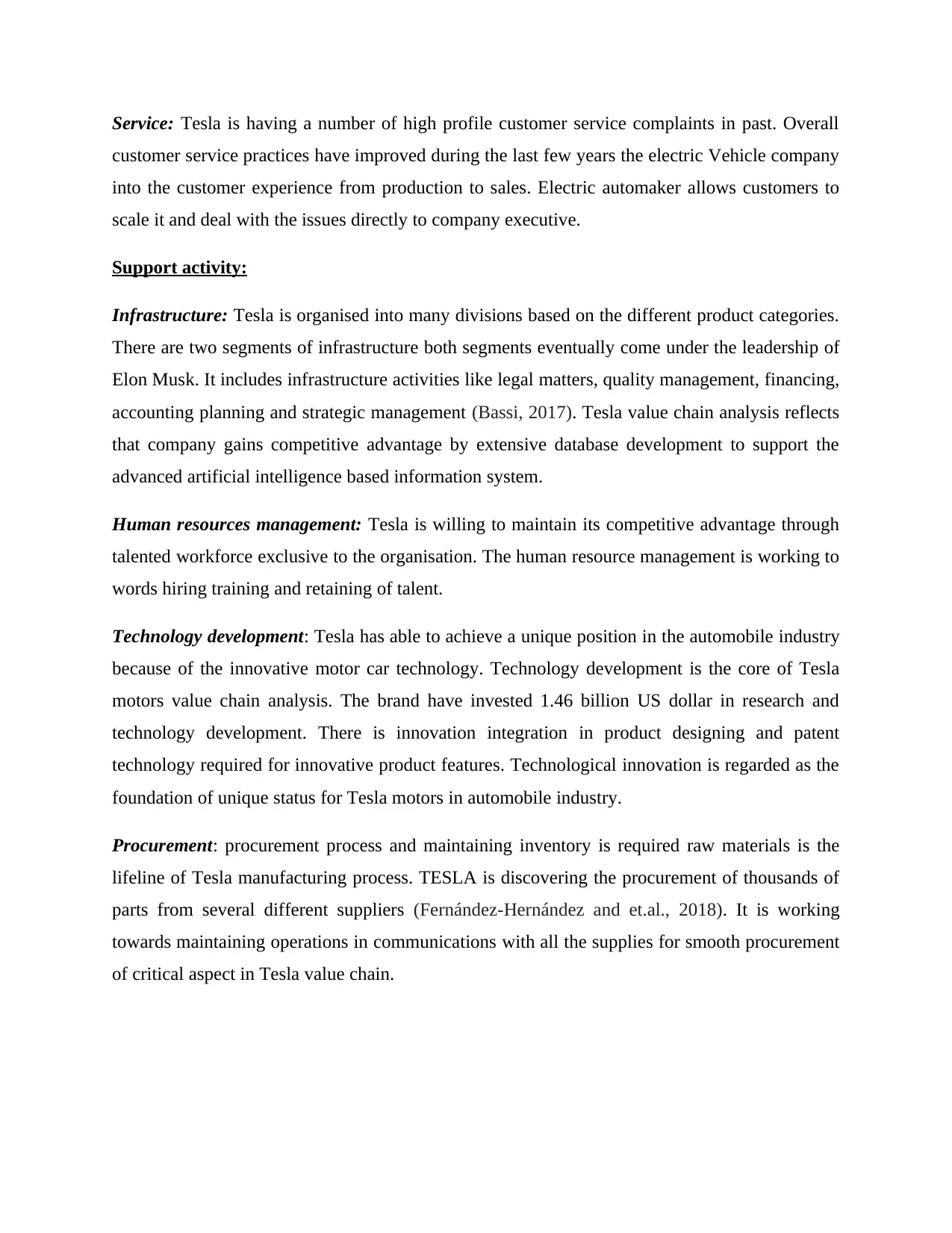
Service: Tesla is having a number of high profile customer service complaints in past. Overall
customer service practices have improved during the last few years the electric Vehicle company
into the customer experience from production to sales. Electric automaker allows customers to
scale it and deal with the issues directly to company executive.
Support activity:
Infrastructure: Tesla is organised into many divisions based on the different product categories.
There are two segments of infrastructure both segments eventually come under the leadership of
Elon Musk. It includes infrastructure activities like legal matters, quality management, financing,
accounting planning and strategic management (Bassi, 2017). Tesla value chain analysis reflects
that company gains competitive advantage by extensive database development to support the
advanced artificial intelligence based information system.
Human resources management: Tesla is willing to maintain its competitive advantage through
talented workforce exclusive to the organisation. The human resource management is working to
words hiring training and retaining of talent.
Technology development: Tesla has able to achieve a unique position in the automobile industry
because of the innovative motor car technology. Technology development is the core of Tesla
motors value chain analysis. The brand have invested 1.46 billion US dollar in research and
technology development. There is innovation integration in product designing and patent
technology required for innovative product features. Technological innovation is regarded as the
foundation of unique status for Tesla motors in automobile industry.
Procurement: procurement process and maintaining inventory is required raw materials is the
lifeline of Tesla manufacturing process. TESLA is discovering the procurement of thousands of
parts from several different suppliers (Fernández-Hernández and et.al., 2018). It is working
towards maintaining operations in communications with all the supplies for smooth procurement
of critical aspect in Tesla value chain.
customer service practices have improved during the last few years the electric Vehicle company
into the customer experience from production to sales. Electric automaker allows customers to
scale it and deal with the issues directly to company executive.
Support activity:
Infrastructure: Tesla is organised into many divisions based on the different product categories.
There are two segments of infrastructure both segments eventually come under the leadership of
Elon Musk. It includes infrastructure activities like legal matters, quality management, financing,
accounting planning and strategic management (Bassi, 2017). Tesla value chain analysis reflects
that company gains competitive advantage by extensive database development to support the
advanced artificial intelligence based information system.
Human resources management: Tesla is willing to maintain its competitive advantage through
talented workforce exclusive to the organisation. The human resource management is working to
words hiring training and retaining of talent.
Technology development: Tesla has able to achieve a unique position in the automobile industry
because of the innovative motor car technology. Technology development is the core of Tesla
motors value chain analysis. The brand have invested 1.46 billion US dollar in research and
technology development. There is innovation integration in product designing and patent
technology required for innovative product features. Technological innovation is regarded as the
foundation of unique status for Tesla motors in automobile industry.
Procurement: procurement process and maintaining inventory is required raw materials is the
lifeline of Tesla manufacturing process. TESLA is discovering the procurement of thousands of
parts from several different suppliers (Fernández-Hernández and et.al., 2018). It is working
towards maintaining operations in communications with all the supplies for smooth procurement
of critical aspect in Tesla value chain.
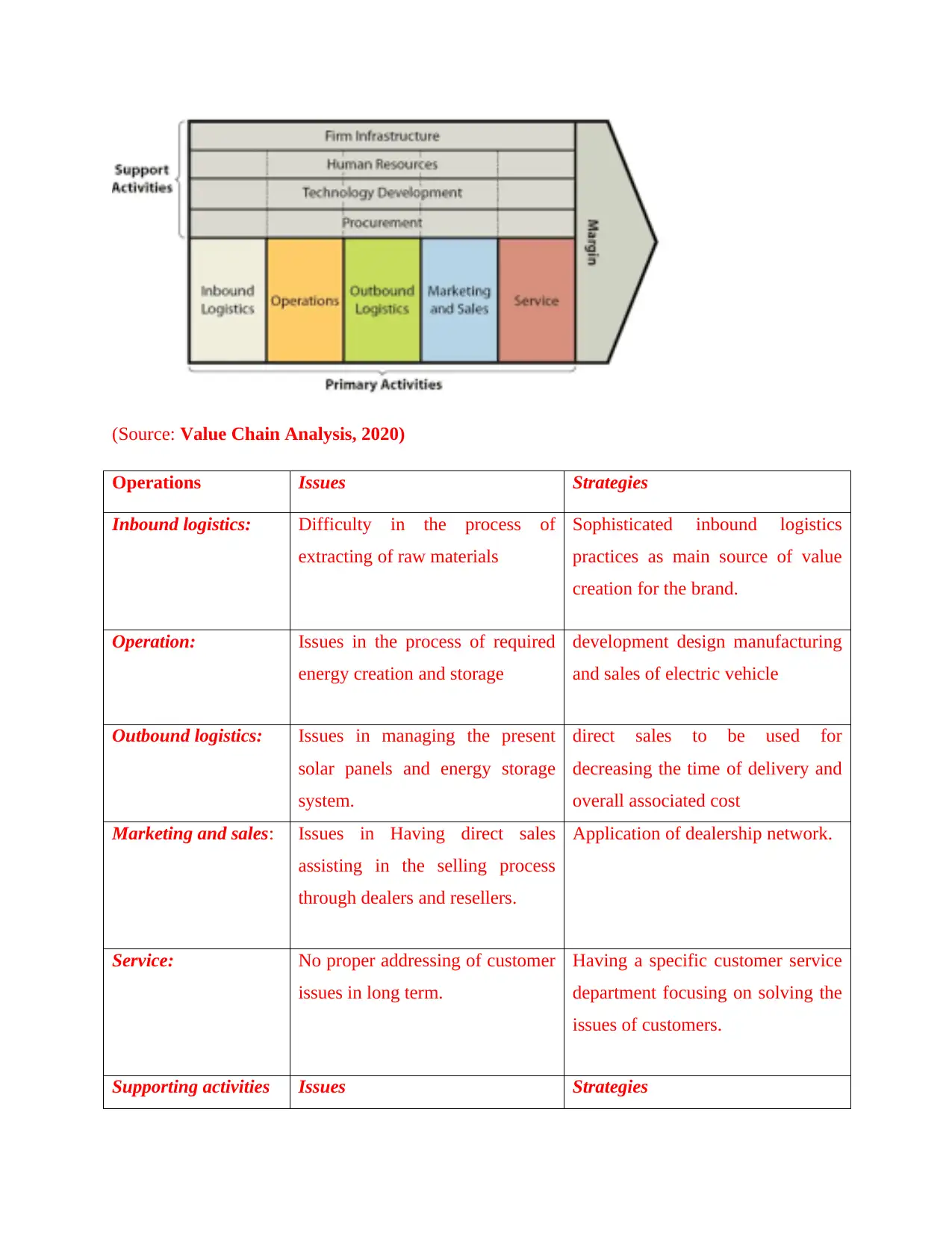
(Source: Value Chain Analysis, 2020)
Operations Issues Strategies
Inbound logistics: Difficulty in the process of
extracting of raw materials
Sophisticated inbound logistics
practices as main source of value
creation for the brand.
Operation: Issues in the process of required
energy creation and storage
development design manufacturing
and sales of electric vehicle
Outbound logistics: Issues in managing the present
solar panels and energy storage
system.
direct sales to be used for
decreasing the time of delivery and
overall associated cost
Marketing and sales: Issues in Having direct sales
assisting in the selling process
through dealers and resellers.
Application of dealership network.
Service: No proper addressing of customer
issues in long term.
Having a specific customer service
department focusing on solving the
issues of customers.
Supporting activities Issues Strategies
Operations Issues Strategies
Inbound logistics: Difficulty in the process of
extracting of raw materials
Sophisticated inbound logistics
practices as main source of value
creation for the brand.
Operation: Issues in the process of required
energy creation and storage
development design manufacturing
and sales of electric vehicle
Outbound logistics: Issues in managing the present
solar panels and energy storage
system.
direct sales to be used for
decreasing the time of delivery and
overall associated cost
Marketing and sales: Issues in Having direct sales
assisting in the selling process
through dealers and resellers.
Application of dealership network.
Service: No proper addressing of customer
issues in long term.
Having a specific customer service
department focusing on solving the
issues of customers.
Supporting activities Issues Strategies
Secure Best Marks with AI Grader
Need help grading? Try our AI Grader for instant feedback on your assignments.
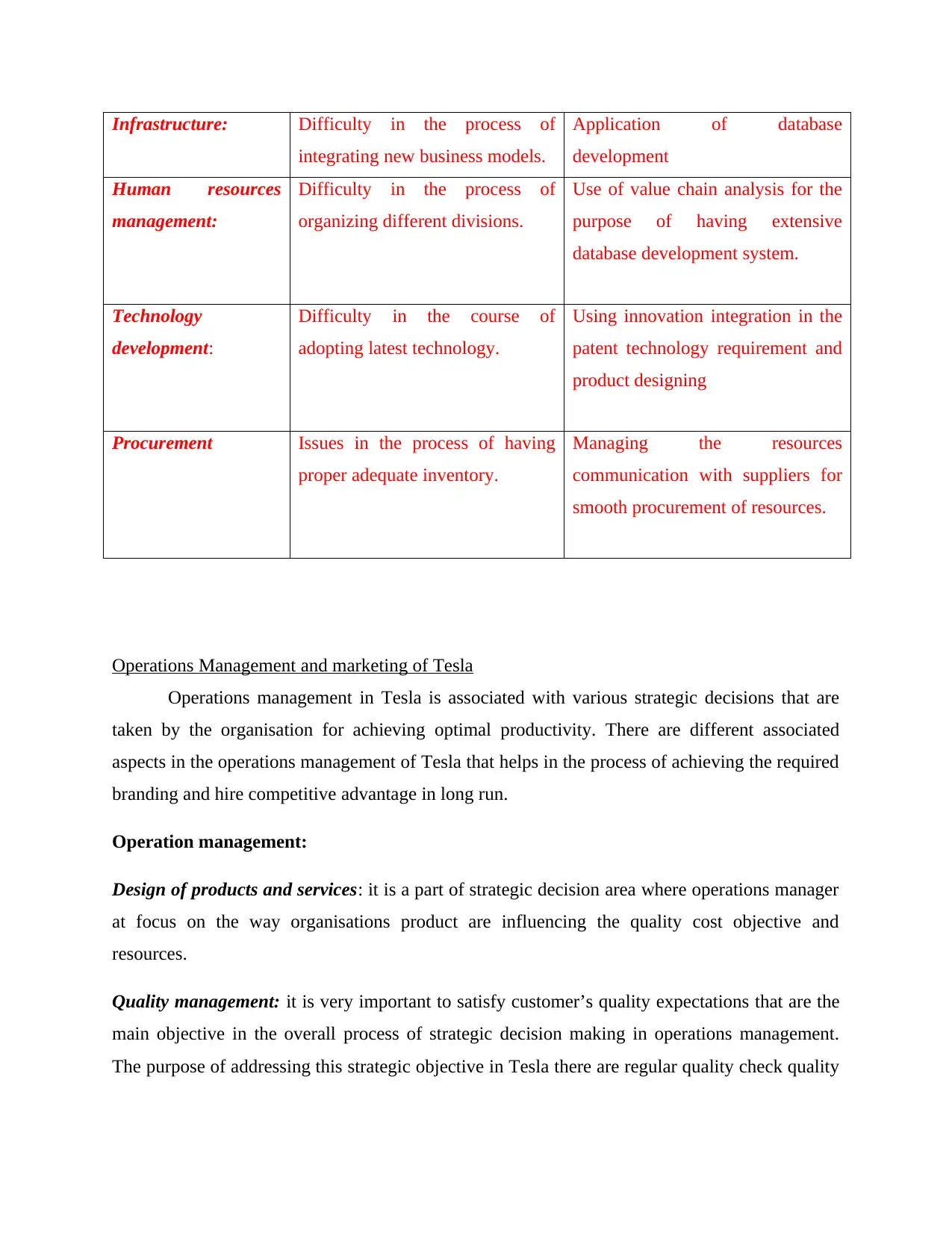
Infrastructure: Difficulty in the process of
integrating new business models.
Application of database
development
Human resources
management:
Difficulty in the process of
organizing different divisions.
Use of value chain analysis for the
purpose of having extensive
database development system.
Technology
development:
Difficulty in the course of
adopting latest technology.
Using innovation integration in the
patent technology requirement and
product designing
Procurement Issues in the process of having
proper adequate inventory.
Managing the resources
communication with suppliers for
smooth procurement of resources.
Operations Management and marketing of Tesla
Operations management in Tesla is associated with various strategic decisions that are
taken by the organisation for achieving optimal productivity. There are different associated
aspects in the operations management of Tesla that helps in the process of achieving the required
branding and hire competitive advantage in long run.
Operation management:
Design of products and services: it is a part of strategic decision area where operations manager
at focus on the way organisations product are influencing the quality cost objective and
resources.
Quality management: it is very important to satisfy customer’s quality expectations that are the
main objective in the overall process of strategic decision making in operations management.
The purpose of addressing this strategic objective in Tesla there are regular quality check quality
integrating new business models.
Application of database
development
Human resources
management:
Difficulty in the process of
organizing different divisions.
Use of value chain analysis for the
purpose of having extensive
database development system.
Technology
development:
Difficulty in the course of
adopting latest technology.
Using innovation integration in the
patent technology requirement and
product designing
Procurement Issues in the process of having
proper adequate inventory.
Managing the resources
communication with suppliers for
smooth procurement of resources.
Operations Management and marketing of Tesla
Operations management in Tesla is associated with various strategic decisions that are
taken by the organisation for achieving optimal productivity. There are different associated
aspects in the operations management of Tesla that helps in the process of achieving the required
branding and hire competitive advantage in long run.
Operation management:
Design of products and services: it is a part of strategic decision area where operations manager
at focus on the way organisations product are influencing the quality cost objective and
resources.
Quality management: it is very important to satisfy customer’s quality expectations that are the
main objective in the overall process of strategic decision making in operations management.
The purpose of addressing this strategic objective in Tesla there are regular quality check quality
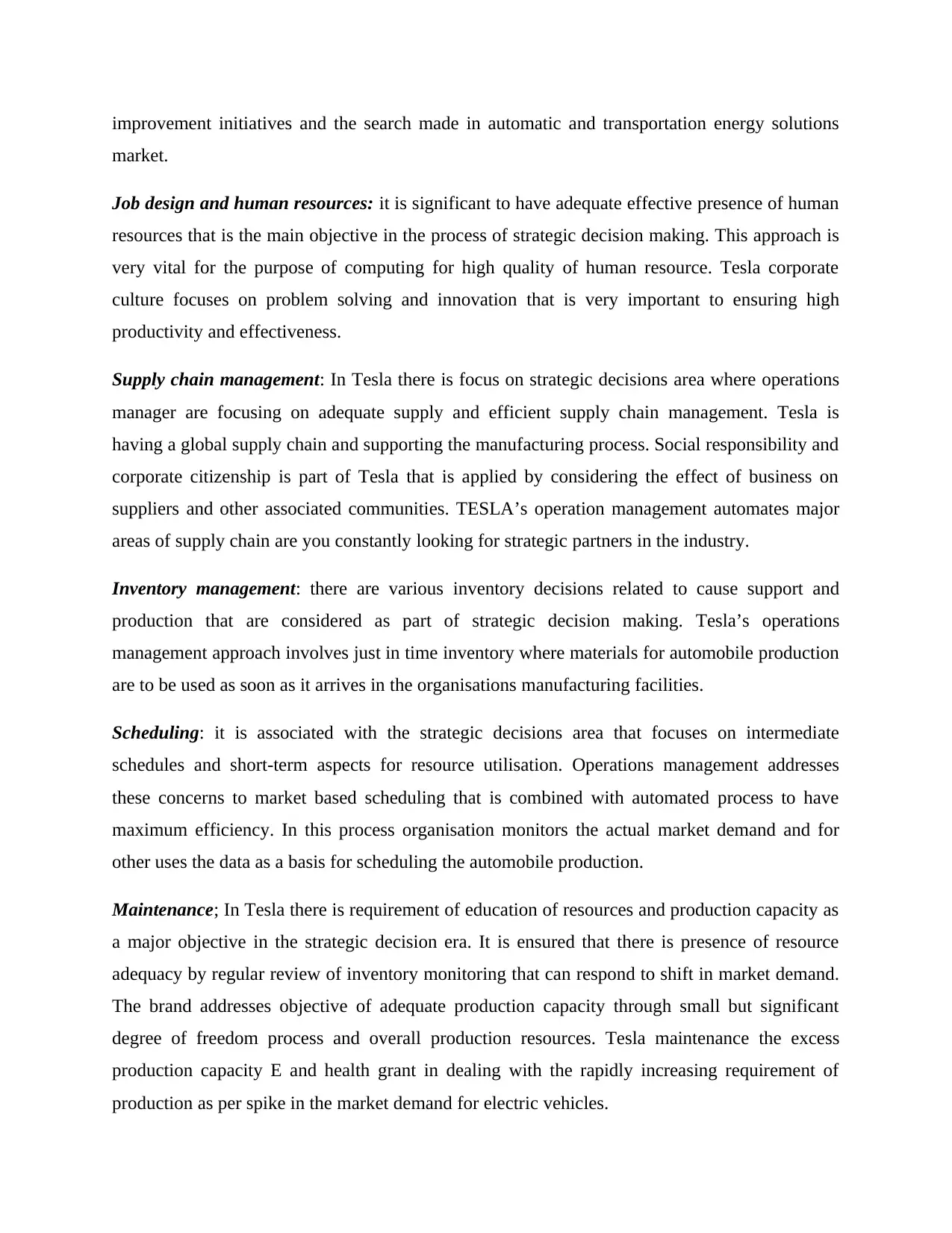
improvement initiatives and the search made in automatic and transportation energy solutions
market.
Job design and human resources: it is significant to have adequate effective presence of human
resources that is the main objective in the process of strategic decision making. This approach is
very vital for the purpose of computing for high quality of human resource. Tesla corporate
culture focuses on problem solving and innovation that is very important to ensuring high
productivity and effectiveness.
Supply chain management: In Tesla there is focus on strategic decisions area where operations
manager are focusing on adequate supply and efficient supply chain management. Tesla is
having a global supply chain and supporting the manufacturing process. Social responsibility and
corporate citizenship is part of Tesla that is applied by considering the effect of business on
suppliers and other associated communities. TESLA’s operation management automates major
areas of supply chain are you constantly looking for strategic partners in the industry.
Inventory management: there are various inventory decisions related to cause support and
production that are considered as part of strategic decision making. Tesla’s operations
management approach involves just in time inventory where materials for automobile production
are to be used as soon as it arrives in the organisations manufacturing facilities.
Scheduling: it is associated with the strategic decisions area that focuses on intermediate
schedules and short-term aspects for resource utilisation. Operations management addresses
these concerns to market based scheduling that is combined with automated process to have
maximum efficiency. In this process organisation monitors the actual market demand and for
other uses the data as a basis for scheduling the automobile production.
Maintenance; In Tesla there is requirement of education of resources and production capacity as
a major objective in the strategic decision era. It is ensured that there is presence of resource
adequacy by regular review of inventory monitoring that can respond to shift in market demand.
The brand addresses objective of adequate production capacity through small but significant
degree of freedom process and overall production resources. Tesla maintenance the excess
production capacity E and health grant in dealing with the rapidly increasing requirement of
production as per spike in the market demand for electric vehicles.
market.
Job design and human resources: it is significant to have adequate effective presence of human
resources that is the main objective in the process of strategic decision making. This approach is
very vital for the purpose of computing for high quality of human resource. Tesla corporate
culture focuses on problem solving and innovation that is very important to ensuring high
productivity and effectiveness.
Supply chain management: In Tesla there is focus on strategic decisions area where operations
manager are focusing on adequate supply and efficient supply chain management. Tesla is
having a global supply chain and supporting the manufacturing process. Social responsibility and
corporate citizenship is part of Tesla that is applied by considering the effect of business on
suppliers and other associated communities. TESLA’s operation management automates major
areas of supply chain are you constantly looking for strategic partners in the industry.
Inventory management: there are various inventory decisions related to cause support and
production that are considered as part of strategic decision making. Tesla’s operations
management approach involves just in time inventory where materials for automobile production
are to be used as soon as it arrives in the organisations manufacturing facilities.
Scheduling: it is associated with the strategic decisions area that focuses on intermediate
schedules and short-term aspects for resource utilisation. Operations management addresses
these concerns to market based scheduling that is combined with automated process to have
maximum efficiency. In this process organisation monitors the actual market demand and for
other uses the data as a basis for scheduling the automobile production.
Maintenance; In Tesla there is requirement of education of resources and production capacity as
a major objective in the strategic decision era. It is ensured that there is presence of resource
adequacy by regular review of inventory monitoring that can respond to shift in market demand.
The brand addresses objective of adequate production capacity through small but significant
degree of freedom process and overall production resources. Tesla maintenance the excess
production capacity E and health grant in dealing with the rapidly increasing requirement of
production as per spike in the market demand for electric vehicles.
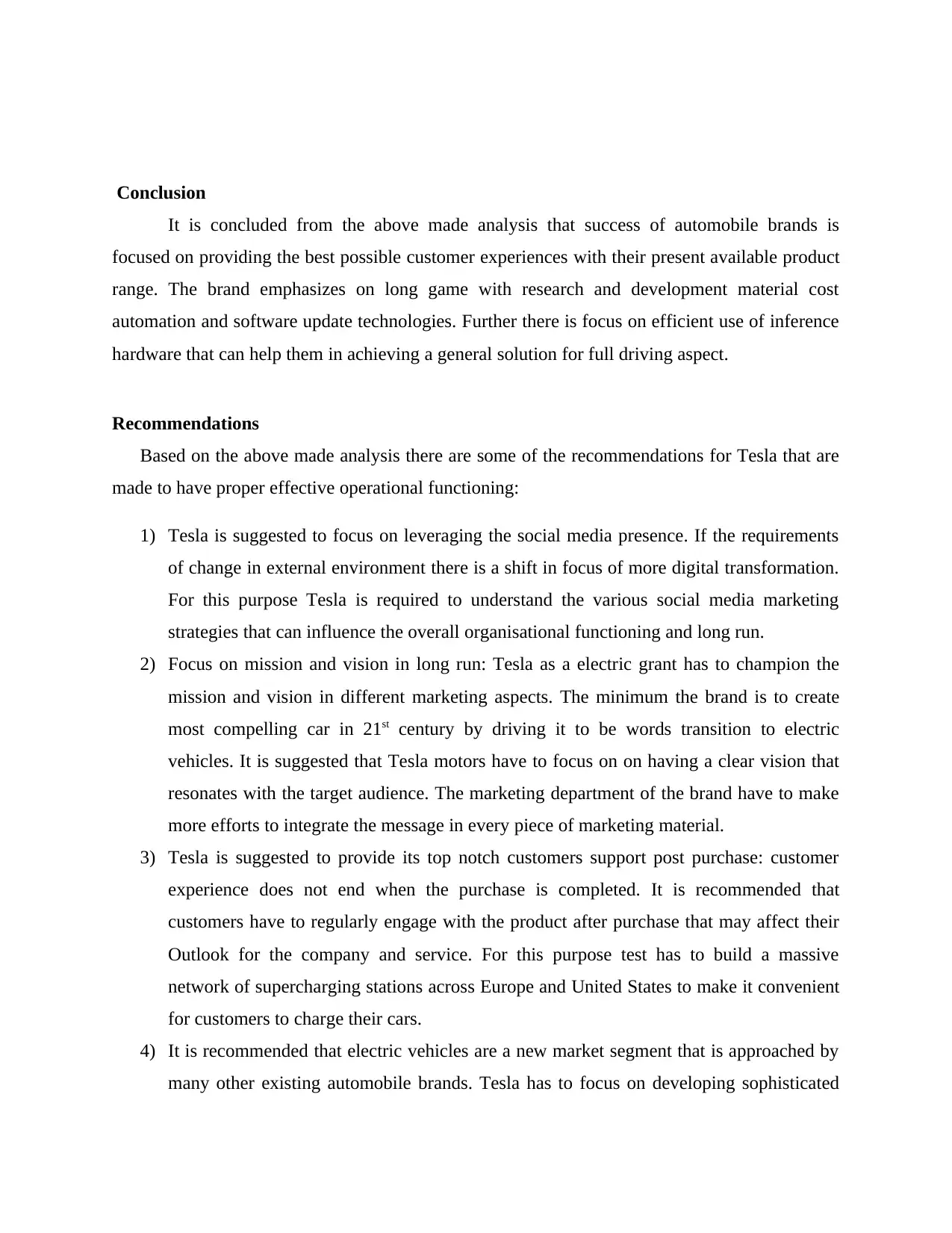
Conclusion
It is concluded from the above made analysis that success of automobile brands is
focused on providing the best possible customer experiences with their present available product
range. The brand emphasizes on long game with research and development material cost
automation and software update technologies. Further there is focus on efficient use of inference
hardware that can help them in achieving a general solution for full driving aspect.
Recommendations
Based on the above made analysis there are some of the recommendations for Tesla that are
made to have proper effective operational functioning:
1) Tesla is suggested to focus on leveraging the social media presence. If the requirements
of change in external environment there is a shift in focus of more digital transformation.
For this purpose Tesla is required to understand the various social media marketing
strategies that can influence the overall organisational functioning and long run.
2) Focus on mission and vision in long run: Tesla as a electric grant has to champion the
mission and vision in different marketing aspects. The minimum the brand is to create
most compelling car in 21st century by driving it to be words transition to electric
vehicles. It is suggested that Tesla motors have to focus on on having a clear vision that
resonates with the target audience. The marketing department of the brand have to make
more efforts to integrate the message in every piece of marketing material.
3) Tesla is suggested to provide its top notch customers support post purchase: customer
experience does not end when the purchase is completed. It is recommended that
customers have to regularly engage with the product after purchase that may affect their
Outlook for the company and service. For this purpose test has to build a massive
network of supercharging stations across Europe and United States to make it convenient
for customers to charge their cars.
4) It is recommended that electric vehicles are a new market segment that is approached by
many other existing automobile brands. Tesla has to focus on developing sophisticated
It is concluded from the above made analysis that success of automobile brands is
focused on providing the best possible customer experiences with their present available product
range. The brand emphasizes on long game with research and development material cost
automation and software update technologies. Further there is focus on efficient use of inference
hardware that can help them in achieving a general solution for full driving aspect.
Recommendations
Based on the above made analysis there are some of the recommendations for Tesla that are
made to have proper effective operational functioning:
1) Tesla is suggested to focus on leveraging the social media presence. If the requirements
of change in external environment there is a shift in focus of more digital transformation.
For this purpose Tesla is required to understand the various social media marketing
strategies that can influence the overall organisational functioning and long run.
2) Focus on mission and vision in long run: Tesla as a electric grant has to champion the
mission and vision in different marketing aspects. The minimum the brand is to create
most compelling car in 21st century by driving it to be words transition to electric
vehicles. It is suggested that Tesla motors have to focus on on having a clear vision that
resonates with the target audience. The marketing department of the brand have to make
more efforts to integrate the message in every piece of marketing material.
3) Tesla is suggested to provide its top notch customers support post purchase: customer
experience does not end when the purchase is completed. It is recommended that
customers have to regularly engage with the product after purchase that may affect their
Outlook for the company and service. For this purpose test has to build a massive
network of supercharging stations across Europe and United States to make it convenient
for customers to charge their cars.
4) It is recommended that electric vehicles are a new market segment that is approached by
many other existing automobile brands. Tesla has to focus on developing sophisticated
Paraphrase This Document
Need a fresh take? Get an instant paraphrase of this document with our AI Paraphraser

technology for the products to deal with the high amount of competition that is past of
external environment.
5) It is suggested that in the present scenario customisation is very important has to focus on
dealing with the cost and enhancing its present market position so that they are able to
achieve higher market share.
external environment.
5) It is suggested that in the present scenario customisation is very important has to focus on
dealing with the cost and enhancing its present market position so that they are able to
achieve higher market share.
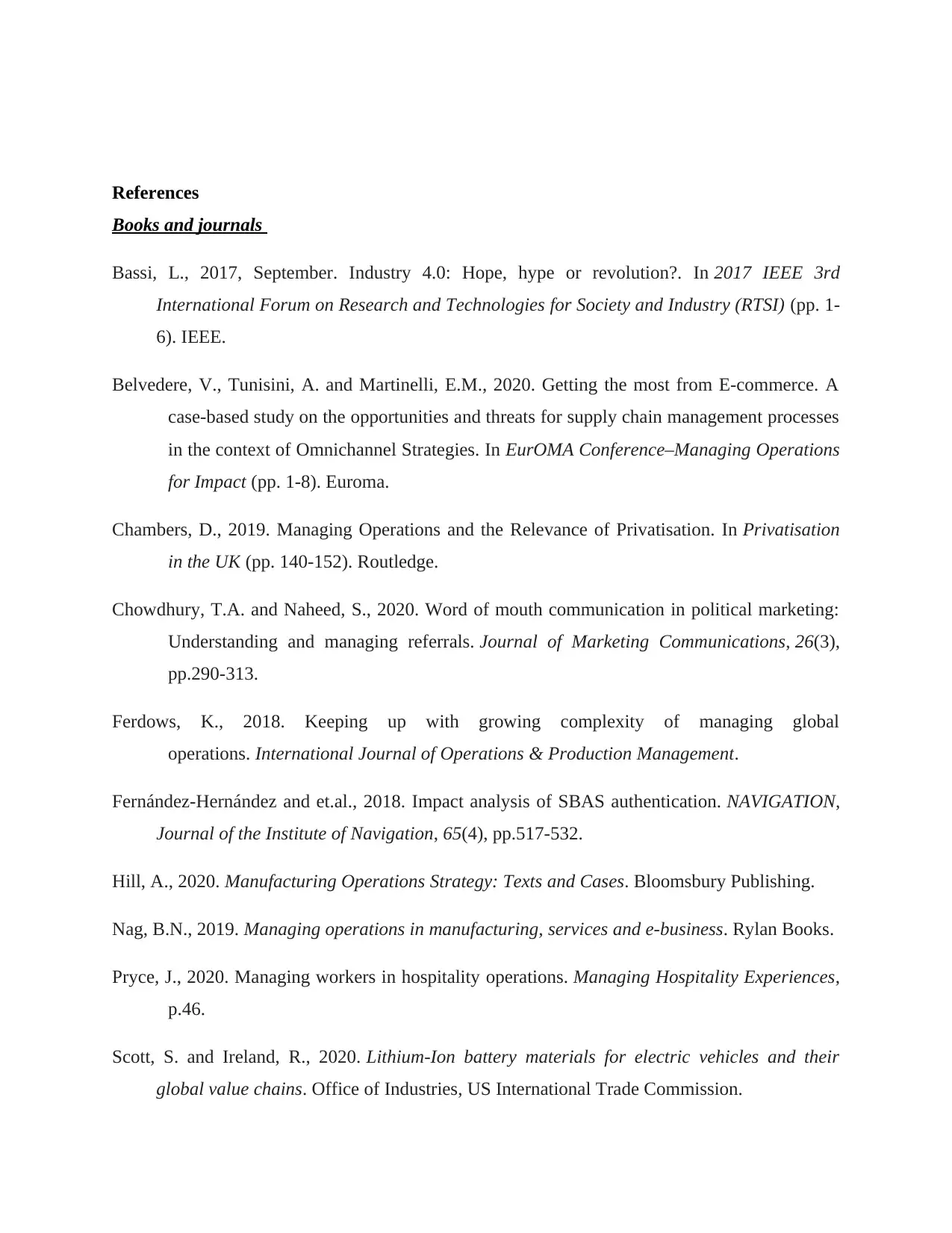
References
Books and journals
Bassi, L., 2017, September. Industry 4.0: Hope, hype or revolution?. In 2017 IEEE 3rd
International Forum on Research and Technologies for Society and Industry (RTSI) (pp. 1-
6). IEEE.
Belvedere, V., Tunisini, A. and Martinelli, E.M., 2020. Getting the most from E-commerce. A
case-based study on the opportunities and threats for supply chain management processes
in the context of Omnichannel Strategies. In EurOMA Conference–Managing Operations
for Impact (pp. 1-8). Euroma.
Chambers, D., 2019. Managing Operations and the Relevance of Privatisation. In Privatisation
in the UK (pp. 140-152). Routledge.
Chowdhury, T.A. and Naheed, S., 2020. Word of mouth communication in political marketing:
Understanding and managing referrals. Journal of Marketing Communications, 26(3),
pp.290-313.
Ferdows, K., 2018. Keeping up with growing complexity of managing global
operations. International Journal of Operations & Production Management.
Fernández-Hernández and et.al., 2018. Impact analysis of SBAS authentication. NAVIGATION,
Journal of the Institute of Navigation, 65(4), pp.517-532.
Hill, A., 2020. Manufacturing Operations Strategy: Texts and Cases. Bloomsbury Publishing.
Nag, B.N., 2019. Managing operations in manufacturing, services and e-business. Rylan Books.
Pryce, J., 2020. Managing workers in hospitality operations. Managing Hospitality Experiences,
p.46.
Scott, S. and Ireland, R., 2020. Lithium-Ion battery materials for electric vehicles and their
global value chains. Office of Industries, US International Trade Commission.
Books and journals
Bassi, L., 2017, September. Industry 4.0: Hope, hype or revolution?. In 2017 IEEE 3rd
International Forum on Research and Technologies for Society and Industry (RTSI) (pp. 1-
6). IEEE.
Belvedere, V., Tunisini, A. and Martinelli, E.M., 2020. Getting the most from E-commerce. A
case-based study on the opportunities and threats for supply chain management processes
in the context of Omnichannel Strategies. In EurOMA Conference–Managing Operations
for Impact (pp. 1-8). Euroma.
Chambers, D., 2019. Managing Operations and the Relevance of Privatisation. In Privatisation
in the UK (pp. 140-152). Routledge.
Chowdhury, T.A. and Naheed, S., 2020. Word of mouth communication in political marketing:
Understanding and managing referrals. Journal of Marketing Communications, 26(3),
pp.290-313.
Ferdows, K., 2018. Keeping up with growing complexity of managing global
operations. International Journal of Operations & Production Management.
Fernández-Hernández and et.al., 2018. Impact analysis of SBAS authentication. NAVIGATION,
Journal of the Institute of Navigation, 65(4), pp.517-532.
Hill, A., 2020. Manufacturing Operations Strategy: Texts and Cases. Bloomsbury Publishing.
Nag, B.N., 2019. Managing operations in manufacturing, services and e-business. Rylan Books.
Pryce, J., 2020. Managing workers in hospitality operations. Managing Hospitality Experiences,
p.46.
Scott, S. and Ireland, R., 2020. Lithium-Ion battery materials for electric vehicles and their
global value chains. Office of Industries, US International Trade Commission.
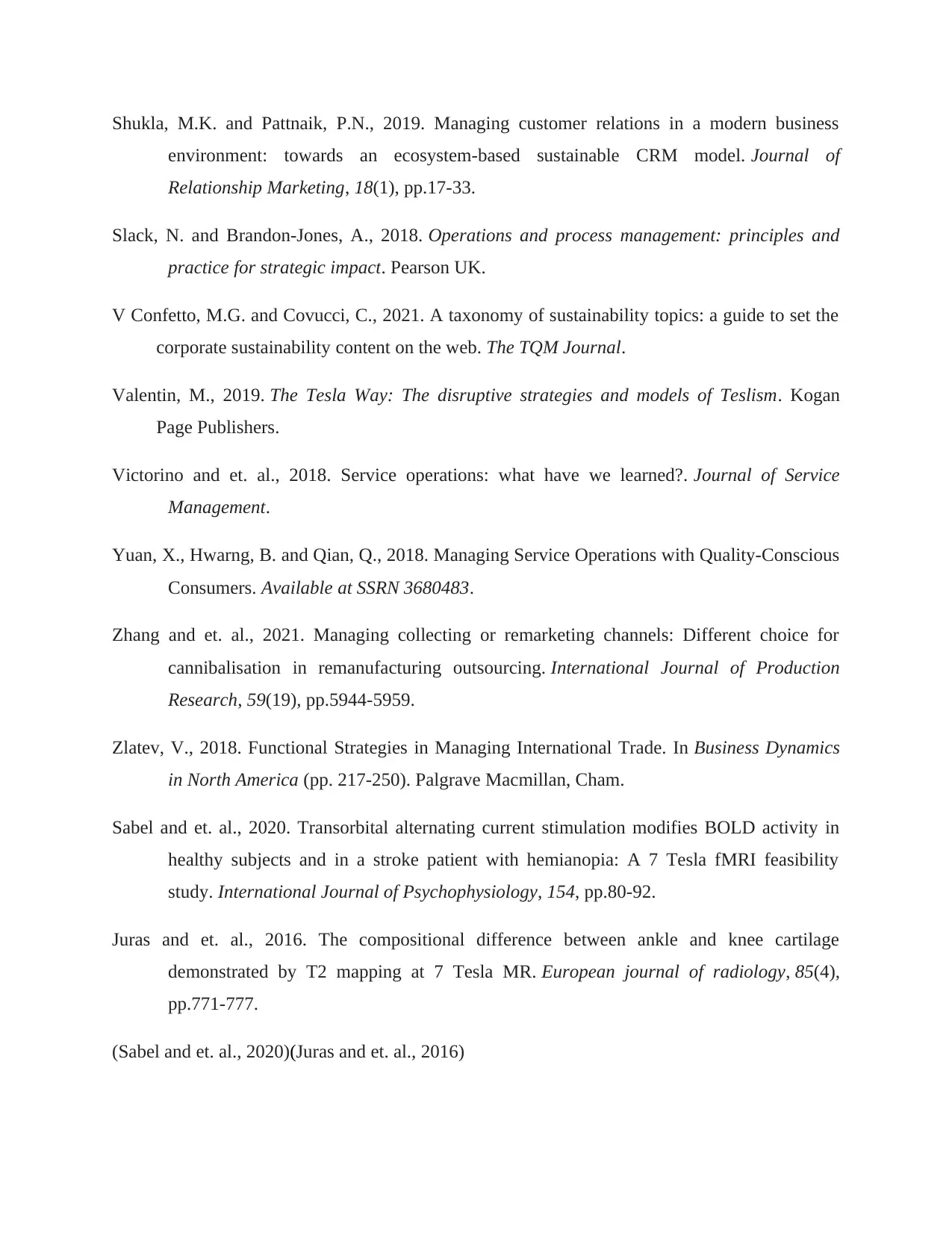
Shukla, M.K. and Pattnaik, P.N., 2019. Managing customer relations in a modern business
environment: towards an ecosystem-based sustainable CRM model. Journal of
Relationship Marketing, 18(1), pp.17-33.
Slack, N. and Brandon-Jones, A., 2018. Operations and process management: principles and
practice for strategic impact. Pearson UK.
V Confetto, M.G. and Covucci, C., 2021. A taxonomy of sustainability topics: a guide to set the
corporate sustainability content on the web. The TQM Journal.
Valentin, M., 2019. The Tesla Way: The disruptive strategies and models of Teslism. Kogan
Page Publishers.
Victorino and et. al., 2018. Service operations: what have we learned?. Journal of Service
Management.
Yuan, X., Hwarng, B. and Qian, Q., 2018. Managing Service Operations with Quality-Conscious
Consumers. Available at SSRN 3680483.
Zhang and et. al., 2021. Managing collecting or remarketing channels: Different choice for
cannibalisation in remanufacturing outsourcing. International Journal of Production
Research, 59(19), pp.5944-5959.
Zlatev, V., 2018. Functional Strategies in Managing International Trade. In Business Dynamics
in North America (pp. 217-250). Palgrave Macmillan, Cham.
Sabel and et. al., 2020. Transorbital alternating current stimulation modifies BOLD activity in
healthy subjects and in a stroke patient with hemianopia: A 7 Tesla fMRI feasibility
study. International Journal of Psychophysiology, 154, pp.80-92.
Juras and et. al., 2016. The compositional difference between ankle and knee cartilage
demonstrated by T2 mapping at 7 Tesla MR. European journal of radiology, 85(4),
pp.771-777.
(Sabel and et. al., 2020)(Juras and et. al., 2016)
environment: towards an ecosystem-based sustainable CRM model. Journal of
Relationship Marketing, 18(1), pp.17-33.
Slack, N. and Brandon-Jones, A., 2018. Operations and process management: principles and
practice for strategic impact. Pearson UK.
V Confetto, M.G. and Covucci, C., 2021. A taxonomy of sustainability topics: a guide to set the
corporate sustainability content on the web. The TQM Journal.
Valentin, M., 2019. The Tesla Way: The disruptive strategies and models of Teslism. Kogan
Page Publishers.
Victorino and et. al., 2018. Service operations: what have we learned?. Journal of Service
Management.
Yuan, X., Hwarng, B. and Qian, Q., 2018. Managing Service Operations with Quality-Conscious
Consumers. Available at SSRN 3680483.
Zhang and et. al., 2021. Managing collecting or remarketing channels: Different choice for
cannibalisation in remanufacturing outsourcing. International Journal of Production
Research, 59(19), pp.5944-5959.
Zlatev, V., 2018. Functional Strategies in Managing International Trade. In Business Dynamics
in North America (pp. 217-250). Palgrave Macmillan, Cham.
Sabel and et. al., 2020. Transorbital alternating current stimulation modifies BOLD activity in
healthy subjects and in a stroke patient with hemianopia: A 7 Tesla fMRI feasibility
study. International Journal of Psychophysiology, 154, pp.80-92.
Juras and et. al., 2016. The compositional difference between ankle and knee cartilage
demonstrated by T2 mapping at 7 Tesla MR. European journal of radiology, 85(4),
pp.771-777.
(Sabel and et. al., 2020)(Juras and et. al., 2016)
Secure Best Marks with AI Grader
Need help grading? Try our AI Grader for instant feedback on your assignments.
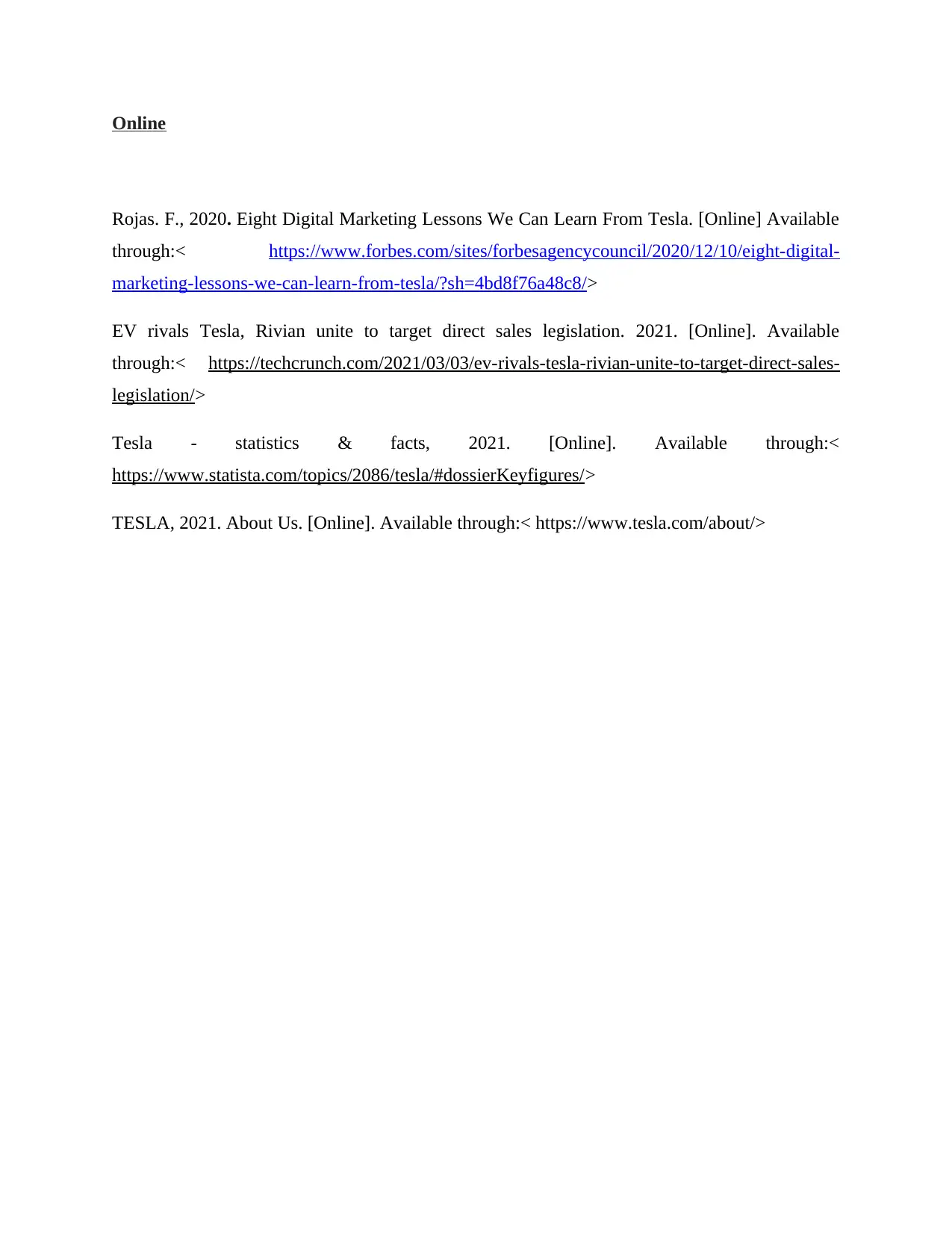
Online
Rojas. F., 2020. Eight Digital Marketing Lessons We Can Learn From Tesla. [Online] Available
through:< https://www.forbes.com/sites/forbesagencycouncil/2020/12/10/eight-digital-
marketing-lessons-we-can-learn-from-tesla/?sh=4bd8f76a48c8/>
EV rivals Tesla, Rivian unite to target direct sales legislation. 2021. [Online]. Available
through:< https://techcrunch.com/2021/03/03/ev-rivals-tesla-rivian-unite-to-target-direct-sales-
legislation/>
Tesla - statistics & facts, 2021. [Online]. Available through:<
https://www.statista.com/topics/2086/tesla/#dossierKeyfigures/>
TESLA, 2021. About Us. [Online]. Available through:< https://www.tesla.com/about/>
Rojas. F., 2020. Eight Digital Marketing Lessons We Can Learn From Tesla. [Online] Available
through:< https://www.forbes.com/sites/forbesagencycouncil/2020/12/10/eight-digital-
marketing-lessons-we-can-learn-from-tesla/?sh=4bd8f76a48c8/>
EV rivals Tesla, Rivian unite to target direct sales legislation. 2021. [Online]. Available
through:< https://techcrunch.com/2021/03/03/ev-rivals-tesla-rivian-unite-to-target-direct-sales-
legislation/>
Tesla - statistics & facts, 2021. [Online]. Available through:<
https://www.statista.com/topics/2086/tesla/#dossierKeyfigures/>
TESLA, 2021. About Us. [Online]. Available through:< https://www.tesla.com/about/>
1 out of 23
Related Documents
Your All-in-One AI-Powered Toolkit for Academic Success.
+13062052269
info@desklib.com
Available 24*7 on WhatsApp / Email
![[object Object]](/_next/static/media/star-bottom.7253800d.svg)
Unlock your academic potential
© 2024 | Zucol Services PVT LTD | All rights reserved.





